Technical Measures to Mitigate Load Fluctuation for Large-Scale Customers to Improve Power System Energy Efficiency
Abstract
1. Introduction
2. Analysis of Load Fluctuation of a Steel Mill
2.1. Korean Operating Reserves
2.2. Load Fluctuation of Steel Mills in Korea
- SL(ω): Magnitude of the disturbance (Spectral density [MW2·sec]);
- A: Proportional constant;
- ω: Angular frequency of the disturbance;
- σD: Standard deviation of the disturbance (MW);
- P: System capacity;
- γ: Proportional constant.
- X: Random variables;
- μ: Average data;
- σ2: Fluctuation data.
3. AGC Program
- Step 1: Input power system data;
- Step 2: Set the reference frequency deviation;
- Step 3: Calculate initial load deviation;
- Step 4: Select simulation mode from among GL, GF, and AGC modes;
- Step 5: Calculate frequency deviation and determine whether frequency error is within the tolerance. If the error is less than the tolerance, go to step 6. Else increase/decrease load deviation by dP and go to step 4;
- Step 6: determine load deviation and calculate cost for ancillary service.
4. An Analysis of Frequency Characteristics
- Mi: Inertia coefficient of the generator;
- Pi: Capacity of the generator;
- Ptotal: Total capacity of the generator.
4.1. An Analysis of the Single Capacity Model
4.2. An Analysis of the Business Type Capacity Model
4.3. An Analysis of the Network Connected Model
4.4. The Results of Frequency Deviation Analysis
5. Frequency Deviation Analysis of a Power System with Compensator
5.1. Compensator Model and Characteristics
5.1.1. Compensator Characteristics
5.1.2. Improved Compensator Control Method
5.2. Case Study
5.2.1. Addition of ESS
5.2.2. GF Operation of a Customer-Owned Generator
5.2.3. Addition of Peak Reduction Generator
5.2.4. Change of Industry Processes
6. Conclusions
Author Contributions
Funding
Conflicts of Interest
References
- Kundur, P. Power System Stability and Control; McGraw-Hill Company: New York, NY, USA, 1994. [Google Scholar]
- Ahmadiahangar, R.; Rosin, A.; Palu, I.; Azizi, A. On the Concept of Flexibility in Electrical Power Systems: Signs of Inflexibility. In SpringerBriefs in Applied Sciences and Technology; Springer: Singapore, 2020. [Google Scholar] [CrossRef]
- Delavari, A.; Kamwa, I. Demand-side contribution to power system frequency regulation: A critical review on decentralized strategies. Int. J. Emerg. Electr. Power Syst. 2017. [CrossRef]
- Delavari, A.; Kamwa, I. Virtual inertia-based load modulation for power system primary frequency regulation. In Proceedings of the IEEE Power Energy Society General Meeting, Chicago, IL, USA, 16–20 July 2017. [Google Scholar]
- Molina-García, A.; Bouffard, F.; Kirschen, D.S. Decentralized demand-side contribution to primary frequency control. IEEE Trans. Power Syst. 2011, 26, 411–419. [Google Scholar]
- Bayat, M.; Sheshyekani, K.; Hamzeh, M.; Rezazadeh, A. Coordination of distributed energy resources and demand response for voltage and frequency support of MV microgrids. IEEE Trans. Power Syst. 2016, 31, 1506–1516. [Google Scholar]
- Dehghanpour, K.; Afsharnia, S. Electrical demand side contribution to frequency control in power systems: A review on technical aspects. Renew. Sustain. Energy Rev. 2015, 41, 1267–1276. [Google Scholar] [CrossRef]
- Nassor, T.S.; Senjyu, T.; Yona, A. Enhancement of voltage stability of dc smart grid during islanded mode by load shedding scheme. Int. J. Emerg. Electr. Power Syst. 2015, 16, 491–501. [Google Scholar] [CrossRef]
- Delavari, A.; Kamwa, I. Improved Optimal Decentralized Load Modulation for Power System Primary Frequency Regulation. IEEE Trans. Power Syst. 2018, 33, 1013–1025. [Google Scholar]
- Song, J.; Pan, X.; Lu, C.; Xu, H. A Simulation-Based Optimization Method for Hybrid Frequency Regulation System Configuration. Energy 2017, 10, 1302. [Google Scholar] [CrossRef]
- Zhang, J.; Lu, C.; Song, J. Dynamic performance-based automatic generation control unit allocation with frequency sensitivity identification. Int. J. Prod. Res. 2016, 54, 6532–6547. [Google Scholar] [CrossRef]
- Kirby, B. Ancillary Services: Technical and Commercial Insights. WÄRTSILÄ 2007, 4, 2012. [Google Scholar]
- O’Neill, J. Demand Response: Electricity Market Benefits & Energy Efficiency Coordination; Nova Science Publishers Inc.: New York, NY, USA, 2013. [Google Scholar]
- Kirby, B.; O’Malley, M.; Ma, O.; Cappers, P.; Corbus, D.; Kiliccote, S.; Onar, O.; Starke, M.; Steinberg, D.; Boston, T.; et al. Load Participation in Ancillary Services; U.S. Department of Energy: Washington, DC, USA, 2011. [Google Scholar]
- Zhang, X.; Hug, G.; Kolter, Z.; Harjunkoski, I. Demand response of Ancillary Service from Industrial Loads Coordinated with Energy Storage. IEEE Trans. Power Syst. 2018, 33, 951–961. [Google Scholar]
- Chau, T.K.; Yu, S.S.; Fernando, T.; Iu, H.H. Demand-Side Regulation Provision from Industrial Loads Integrated with Solar PV Panels and Energy Storage System for Ancillary Services. IEEE Trans. Ind. Inform. 2018, 14, 5038–5049. [Google Scholar] [CrossRef]
- Kirby, B.; Hirst, E. Customer-Specific Metrics for The Regulation and Load-Following Ancillary Services; ORNL/CON-474; Oak Ridge National Laboratory: Oak Ridge, TN, USA, 2000. [Google Scholar]
- Hirst, E.; Kirby, B. Electric Power Ancillary Services; ORNL/CON-426; Oak Ridge National Laboratory: Oak Ridge, TN, USA, 1996. [Google Scholar]
- Lee, G.J.; Moon, S.P.; Seo, I.Y.; Lee, H.C.; Gim, J.H.; Lee, Y.S.; Jung, J.M. The effects and mitigation policies for load fluctuation of large-scale customers. World Electr. Kiee 2014, 63, 20–31. [Google Scholar]
- The Value of Reliability in Power Systems-Pricing Operating Reserves; MIT EL99-005 WP; Energy Laboratory, Massachusetts Institute of Technology: Cambridge, MA, USA, 1999.
- Kirby, B.; Hirst, E. Unbundling Electricity: Ancillary services. IEEE Power Eng. Rev. 1996, 16, 5–6. [Google Scholar] [CrossRef]
- Power Market Operating Rules; Korea Power Exchange (KPX): Naju-si, Bitgaram-ro, Korea, 2019.
- Li, N.; Chen, L.; Dahleh, M. Demand response using linear supply function bidding. IEEE Trans. Smart Grid 2015, 6, 1827–1838. [Google Scholar] [CrossRef]
- Kamyab, F.; Amini, M.; Sheykhha, S.; Hasanpour, M.; Jalali, M.M. Demand response program in smart grid using supply function bidding mechanism. IEEE Trans. Smart Grid 2016, 7, 1277–1284. [Google Scholar] [CrossRef]
- Paulus, M.; Borggrefe, F. The potential of demand-side management in energy-intensive industries for electricity markets in Germany. Appl. Energy 2011, 88, 432–441. [Google Scholar] [CrossRef]
- Load Frequency Control of Power System, Institute of Electrical Engineers of Japan;Technical Report. 1977. Available online: https://www.bookpark.ne.jp/cm/ieej/detail.asp?content_id=IEEJ-GH2-040-PRT (accessed on 3 September 2020).
- Zhang, X.; Hug, G.; Harjunkoski, I. Cost-effective scheduling of steel plants with flexible EAFs. IEEE Trans. Smart Grid 2017, 8, 239–249. [Google Scholar] [CrossRef]
- Energy Storage for Power Systems Applications: A Regional Assessment for the Northwest Power Pool (NWPP); PNNL-19300, DOE; Pacific Northwest National Lab (PNNL): Richland, WA, USA, 2010.
- Wolak, F.A. An Ancillary Services Payment Mechanism for the Chilean Electricity Supply Industry; Stanford University: Stanford, CA, USA, 2011. [Google Scholar]
- Chu, W.C.; Chen, Y.P. Feasible Strategy for Allocating Cost of Primary Frequency Regulation. IEEE Trans. Power Syst. 2009, 24, 508–515. [Google Scholar]
- Shoults, R.R.; Yao, M.; Kelm, R.; Maratukulam, D. Improved system AGC performance with arc furnace steel mill loads. IEEE Trans. Power Syst. 1998, 13, 630–635. [Google Scholar]
- Energy and Ancillary Service Market Operations; PJM Manual 11. Available online: https://www.pjm.com/-/media/documents/manuals/archive/m11/m11v87-energy-and-ancillary-services-market-operations-03-23-2017.ashx (accessed on 23 March 2017).
- Alanis, A.Y. Electricity prices forecasting using artificial neural networks. IEEE Lat. Am. Trans. 2018, 16, 105–111. [Google Scholar] [CrossRef]
- Mahmud, K.; Sahoo, A. Multistage energy management system using autoregressive moving average and artificial neural network for day-ahead peak shaving. Electron. Lett. 2019, 55, 853–855. [Google Scholar] [CrossRef]
- Karim, S.A.A.; Alwi, S.A. Electricity Load Forecasting in UTP Using Moving Averages and Exponential Smoothing Techniques. Hikari Ltd Appl. Math. Sci. 2013, 7, 4003–4014. [Google Scholar] [CrossRef]
- Patel, D.P.; Vajpayee, A.; Dangra, J. Short Term Load Forecasting by Using Time Series Analysis through Smoothing Techniques. Int. J. Eng. Res. Technol.-Comput. Sci. 2013, 2, 1110–1114. [Google Scholar]
- Nowicka-Zagrajek, J.; Weron, R. Modeling electricity loads in California: ARMA models with hyperbolic noise. Signal Process. 2002, 82, 1903–1915. [Google Scholar] [CrossRef]
- Seo, I.Y.; Lee, G.J.; Moon, S.P.; Gim, J.H.; Lee, H.S.; Jung, Y.I.; Lee, Y.H.; Lee, H.C.; Lee, Y.S.; Lee, J.W.; et al. A Study on Load Variance Fluctuation Reduction Counter Measures for Power Production Cost Saving; KEPCO Final Report; KEPCO: Naju-si, Jeollyeok-ro, Korea, 2014. [Google Scholar]
- Lee, Y.S. The Effects of Load Fluctuation on the Load Frequency Control of Power System. Ph.D. Thesis, Sunchon University, Suncheon-si, Jungang-ro, Korea, 2016. [Google Scholar]
- Seo, I.Y.; Moon, S.P.; Lee, Y.H.; Lee, G.J.; Gim, J.H. A Simulation Study for the Influence of Load Fluctuation on Power System. In Proceedings of the Information and Control Symposium, Boryeong-si, Korea, 17–19 October 2013; pp. 414–415. [Google Scholar]
- Gim, J.H.; Lee, Y.S.; Jung, J.M. A Study on the Improvement of Primary Frequency Regulation for Load Fluctuation. In Proceedings of the International Conference on Electrical Engineering, Weihai, China, 4–7 July 2017; pp. 928–932. [Google Scholar]
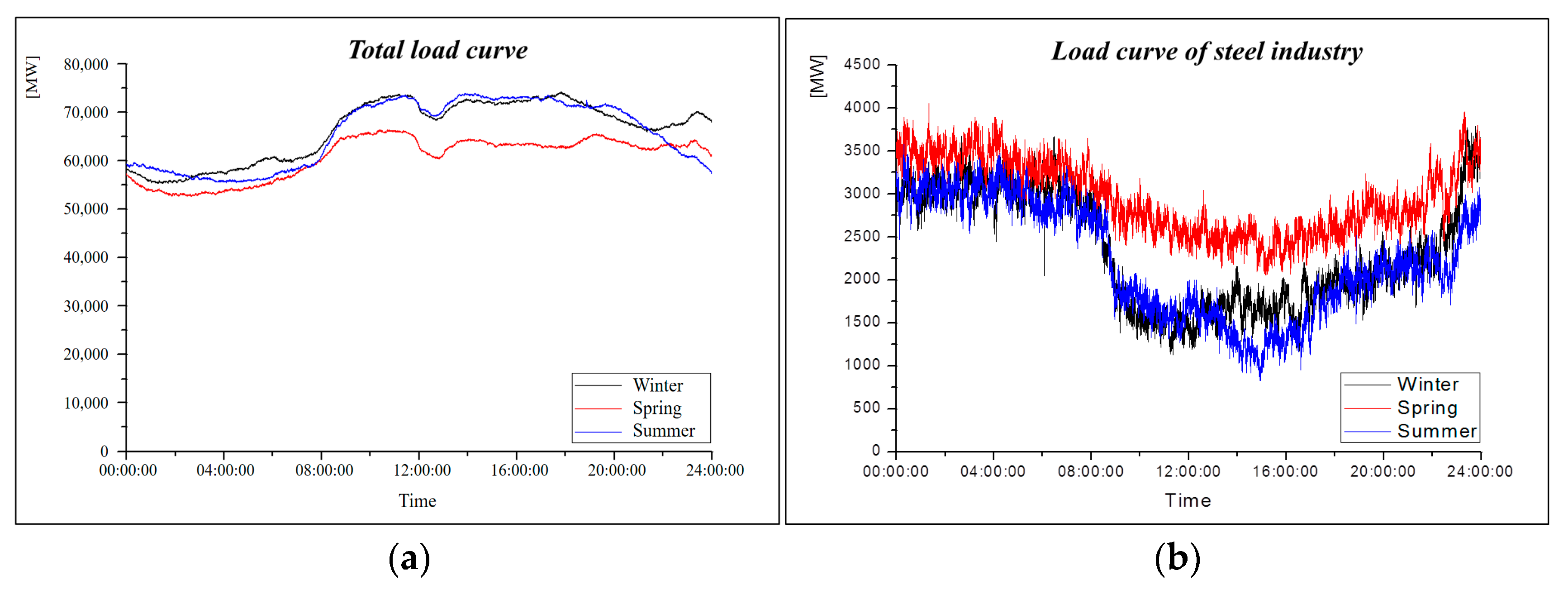
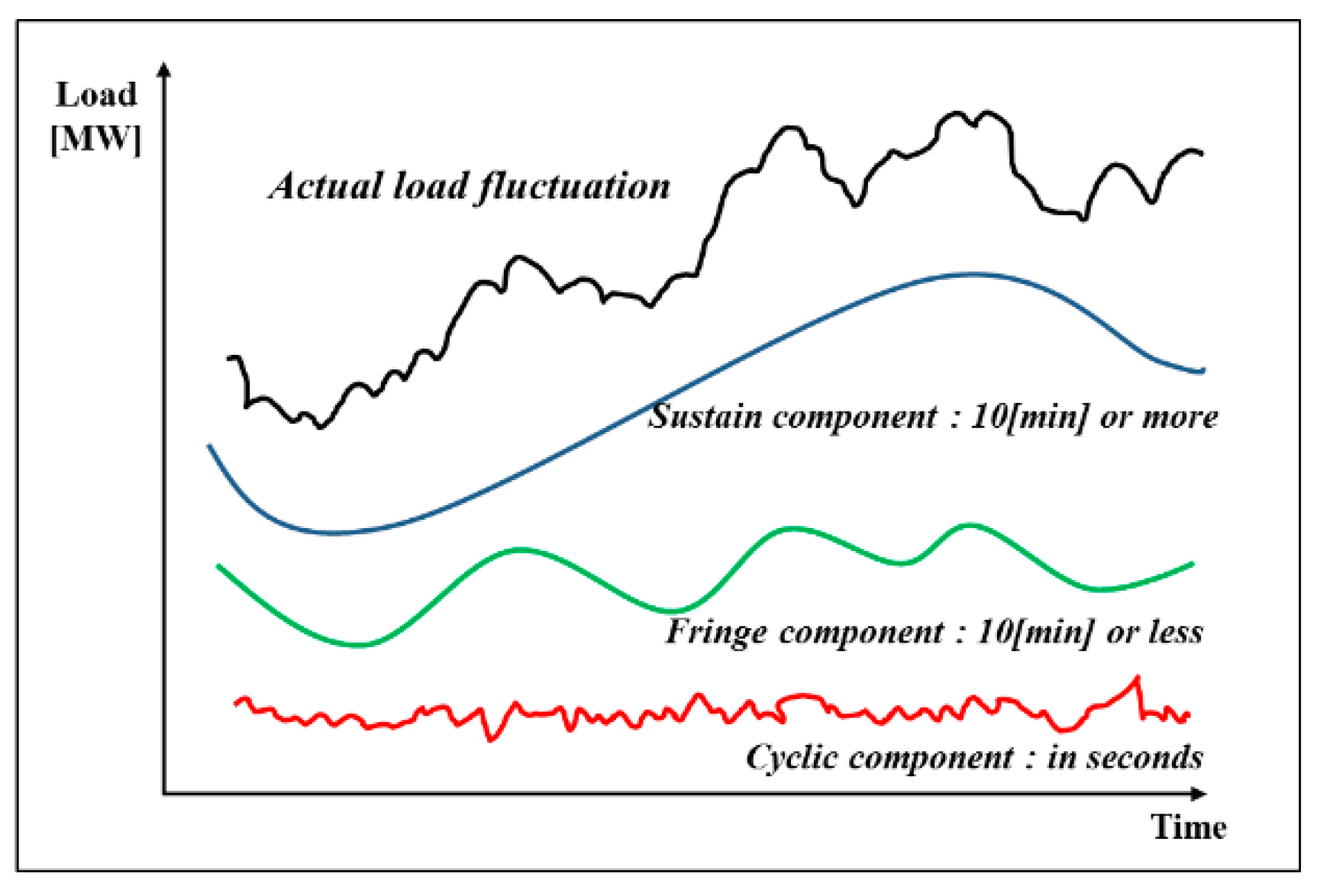

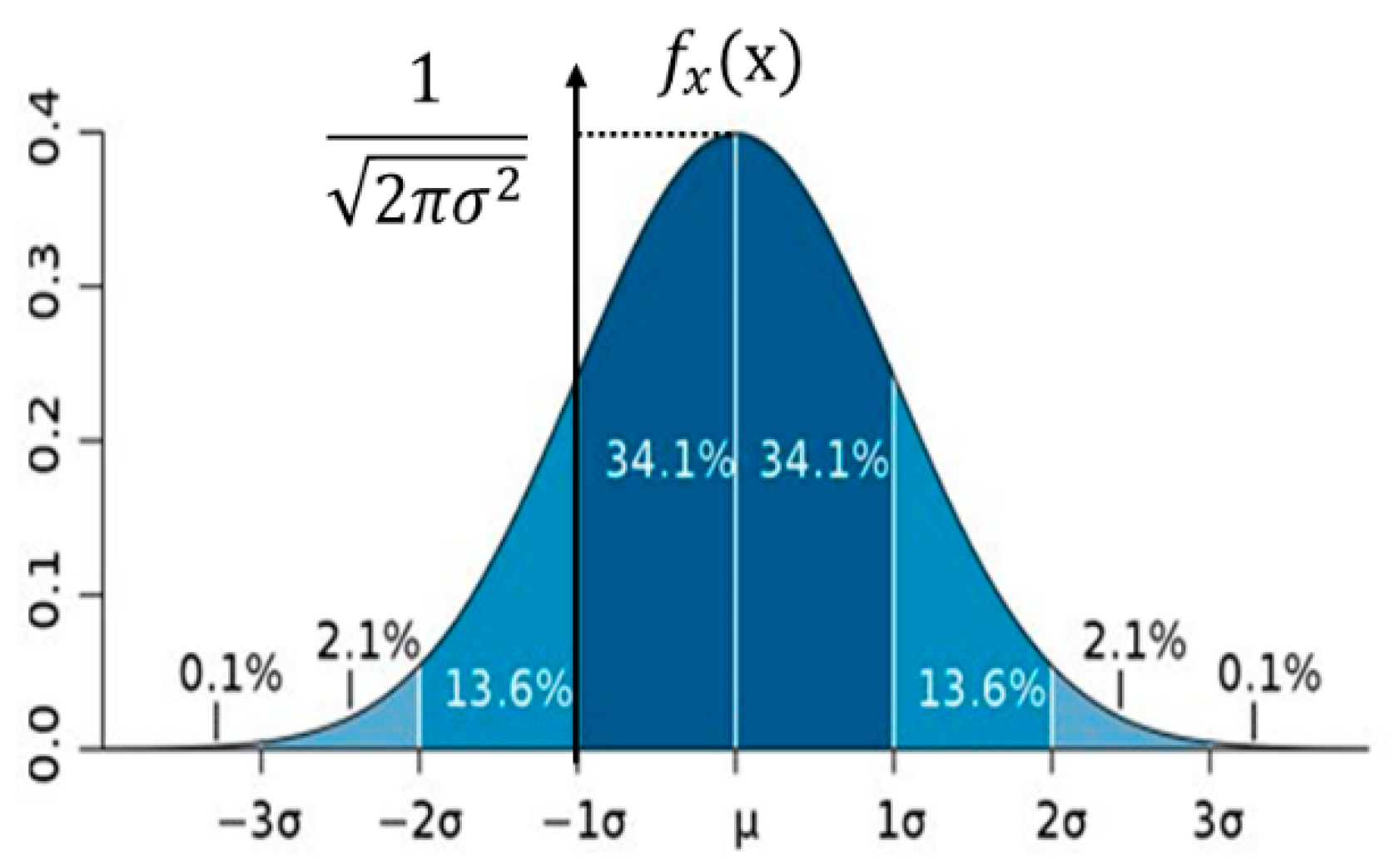
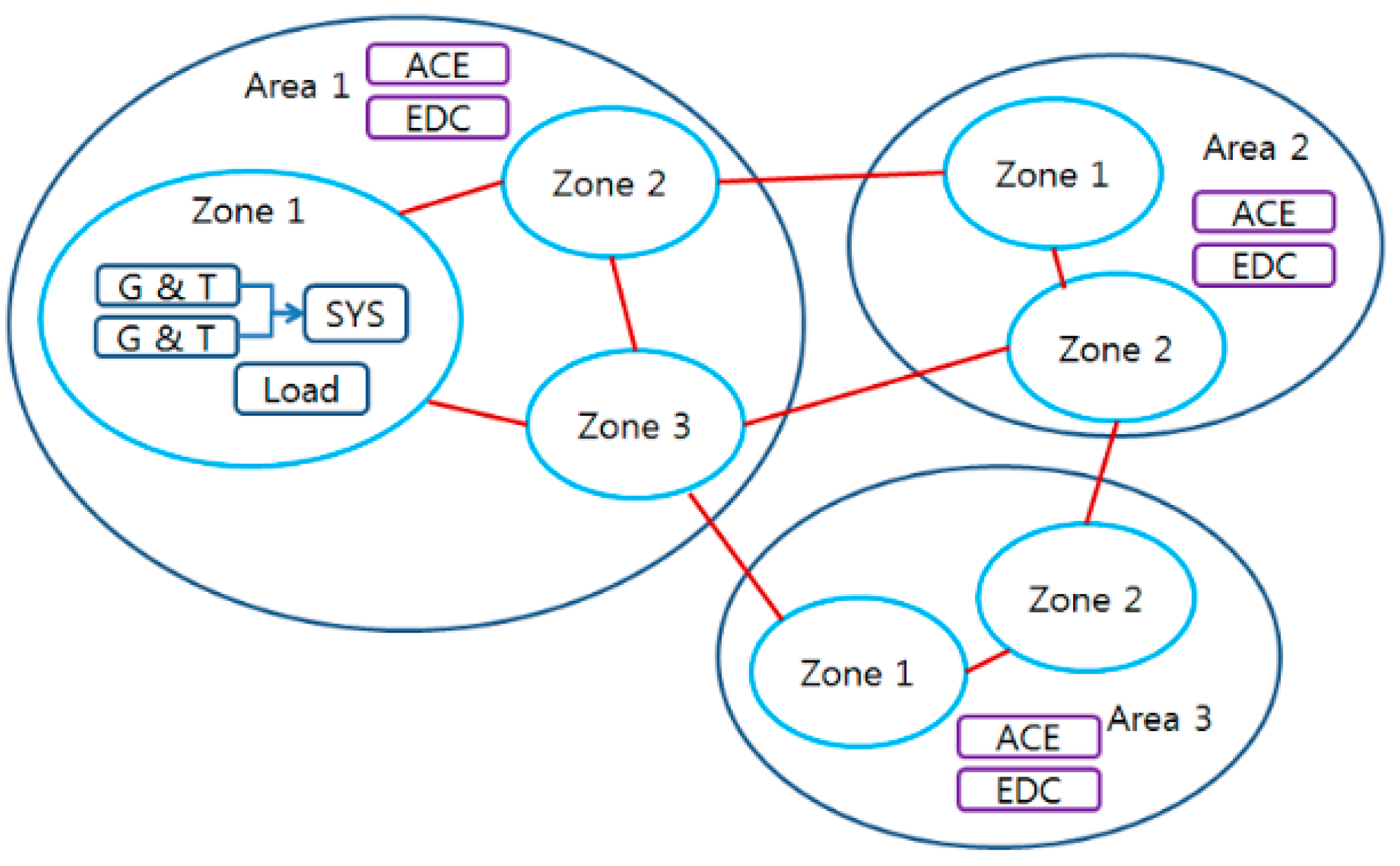
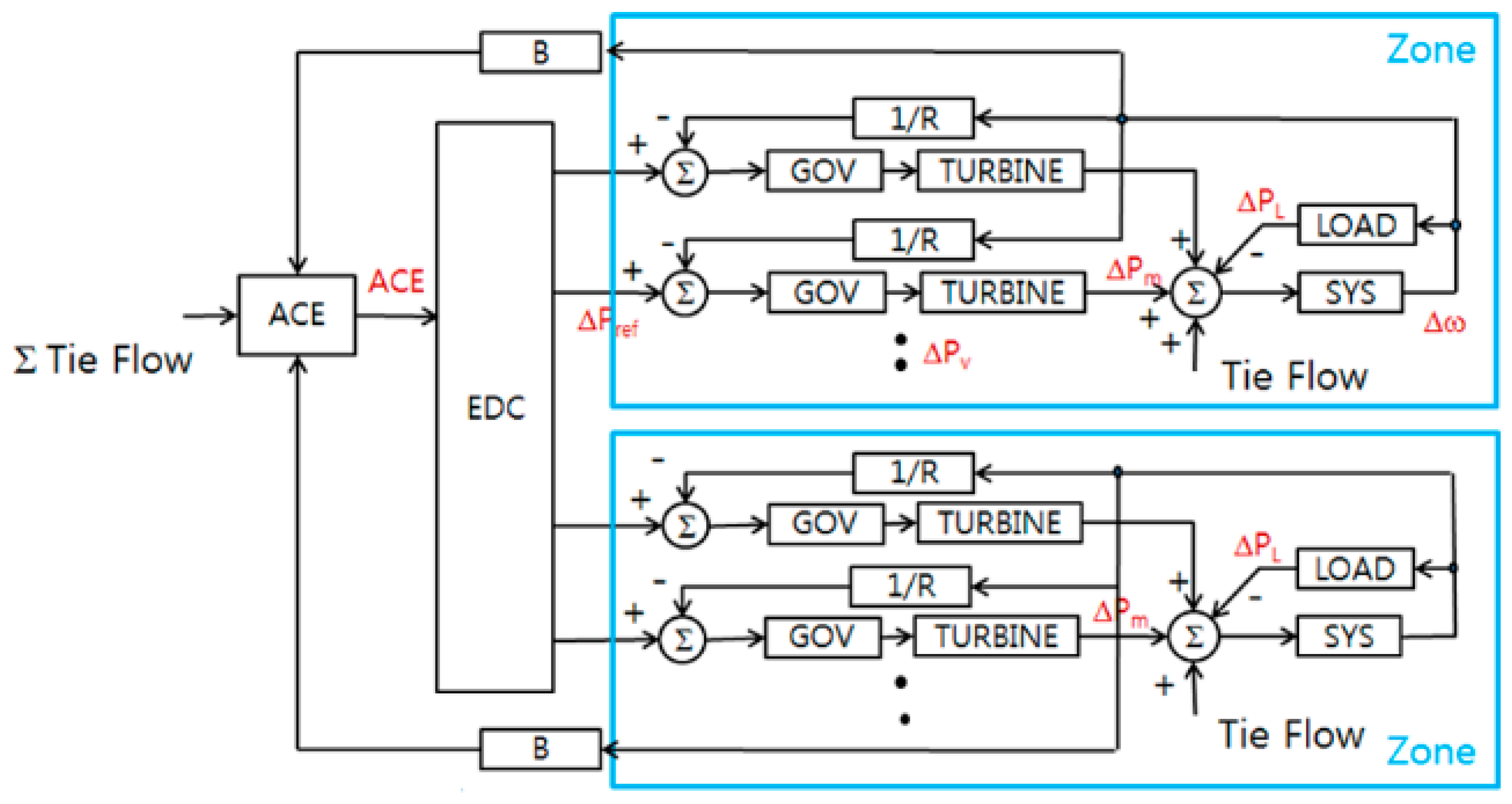
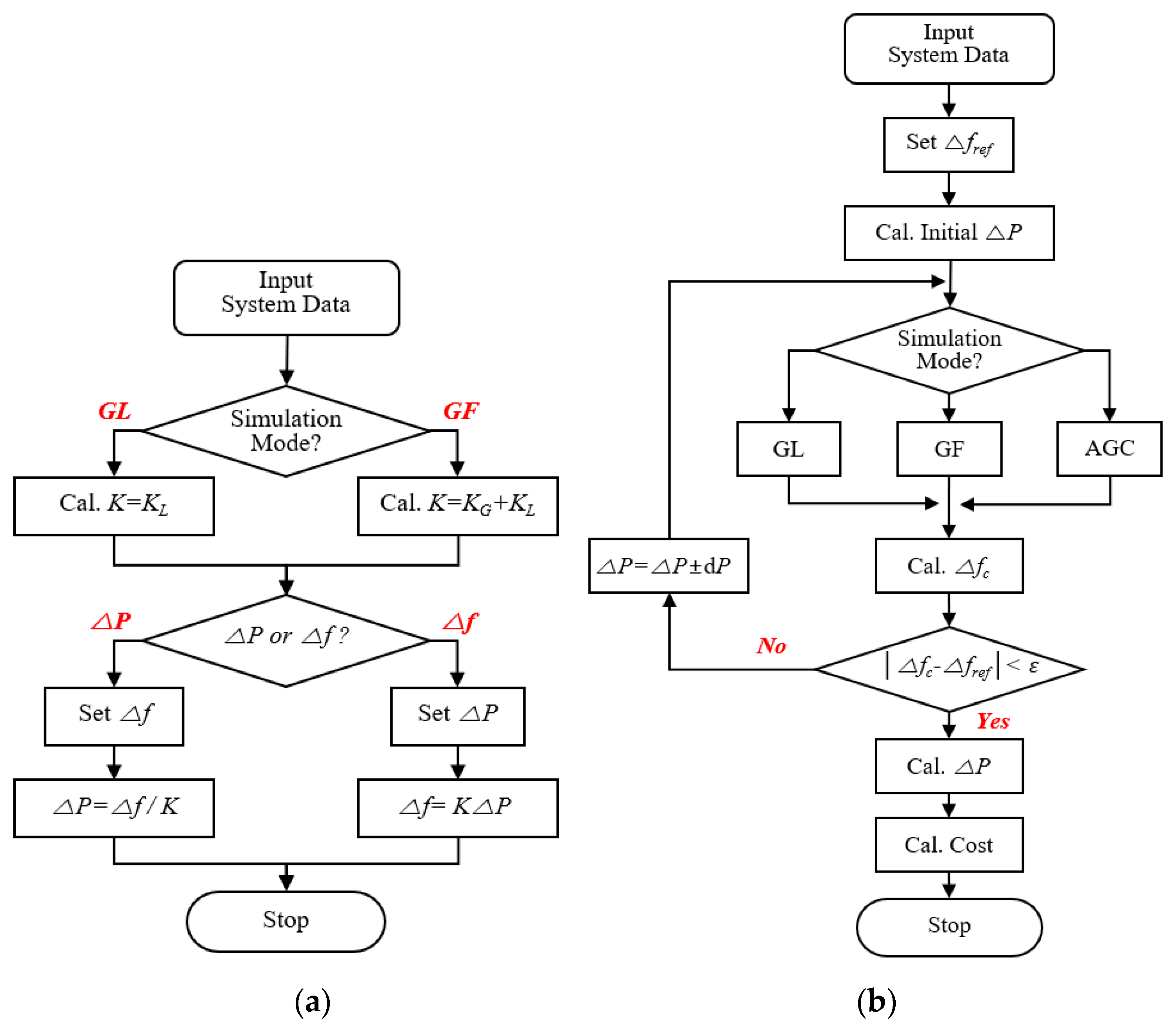

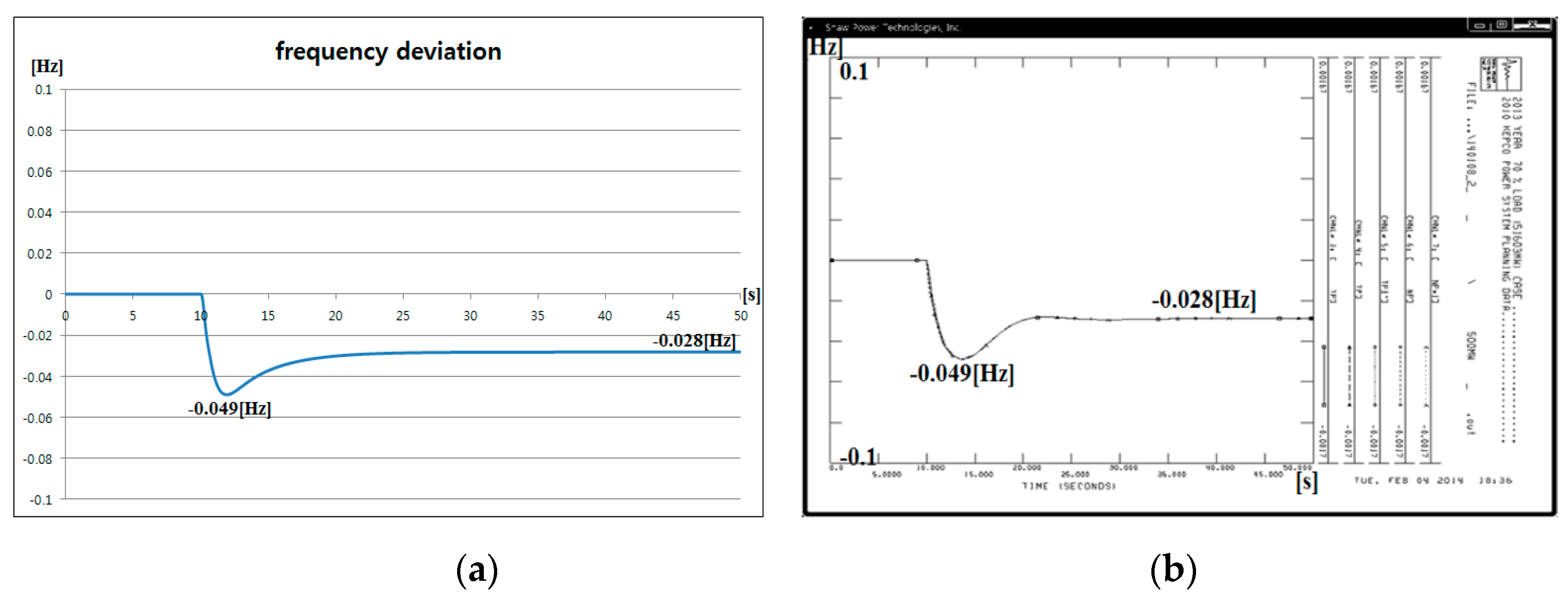
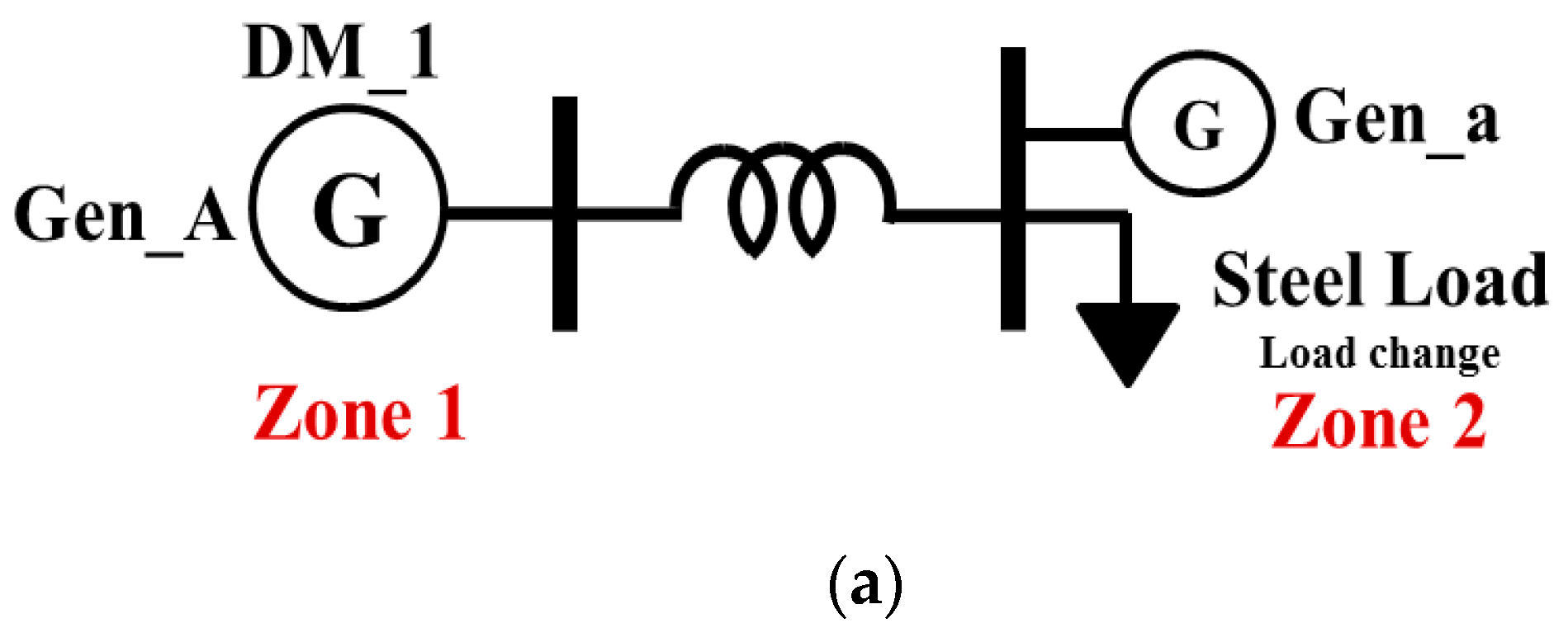
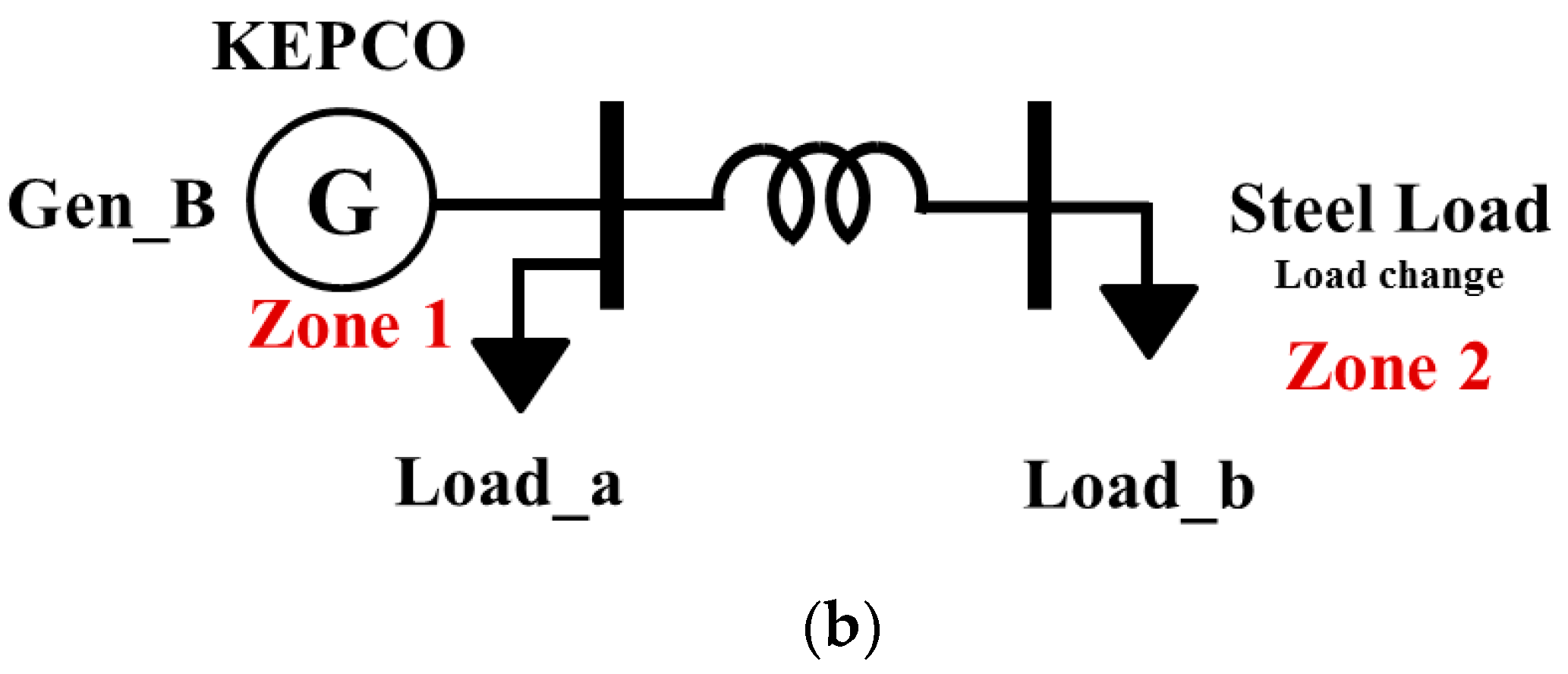
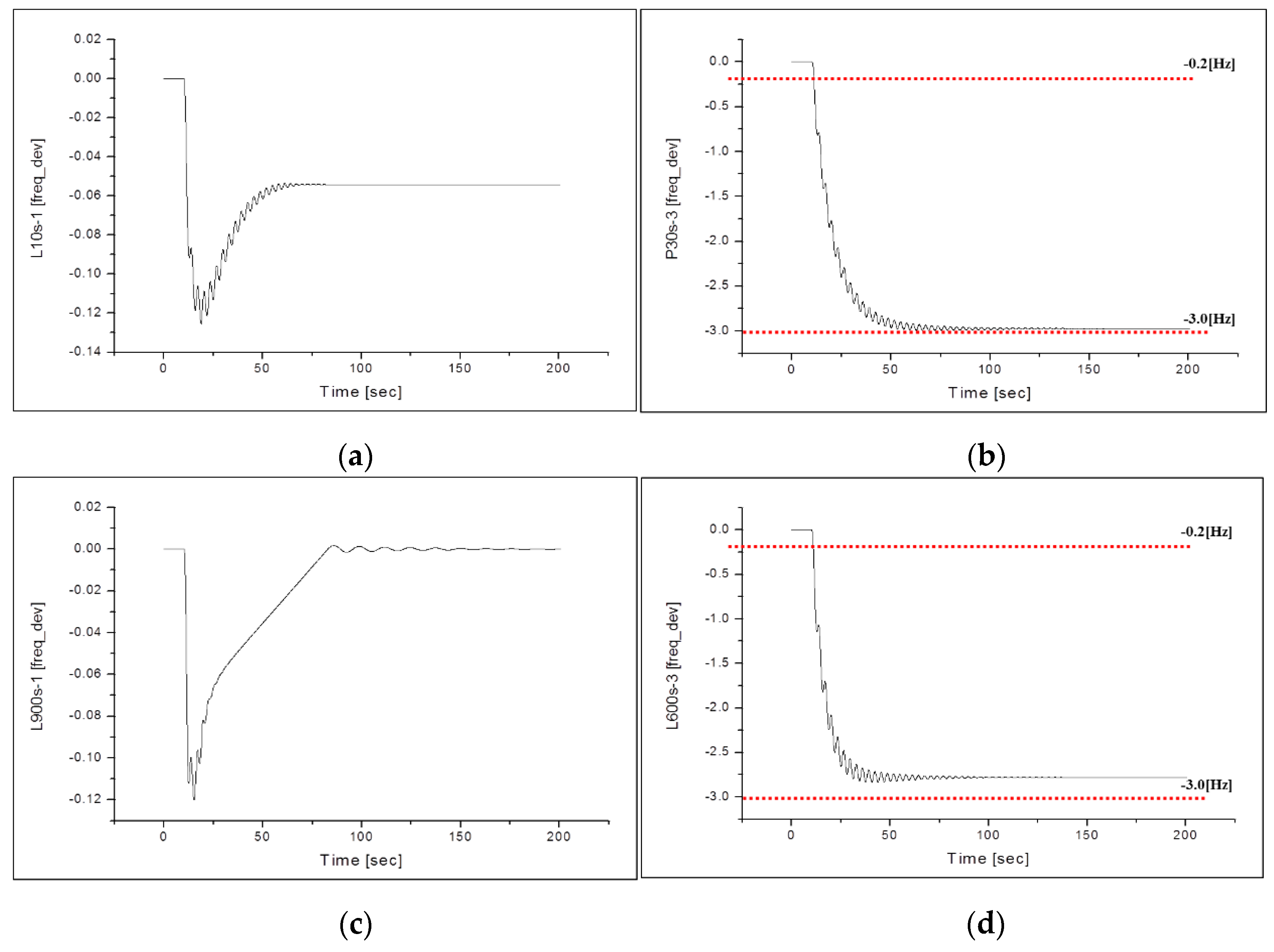
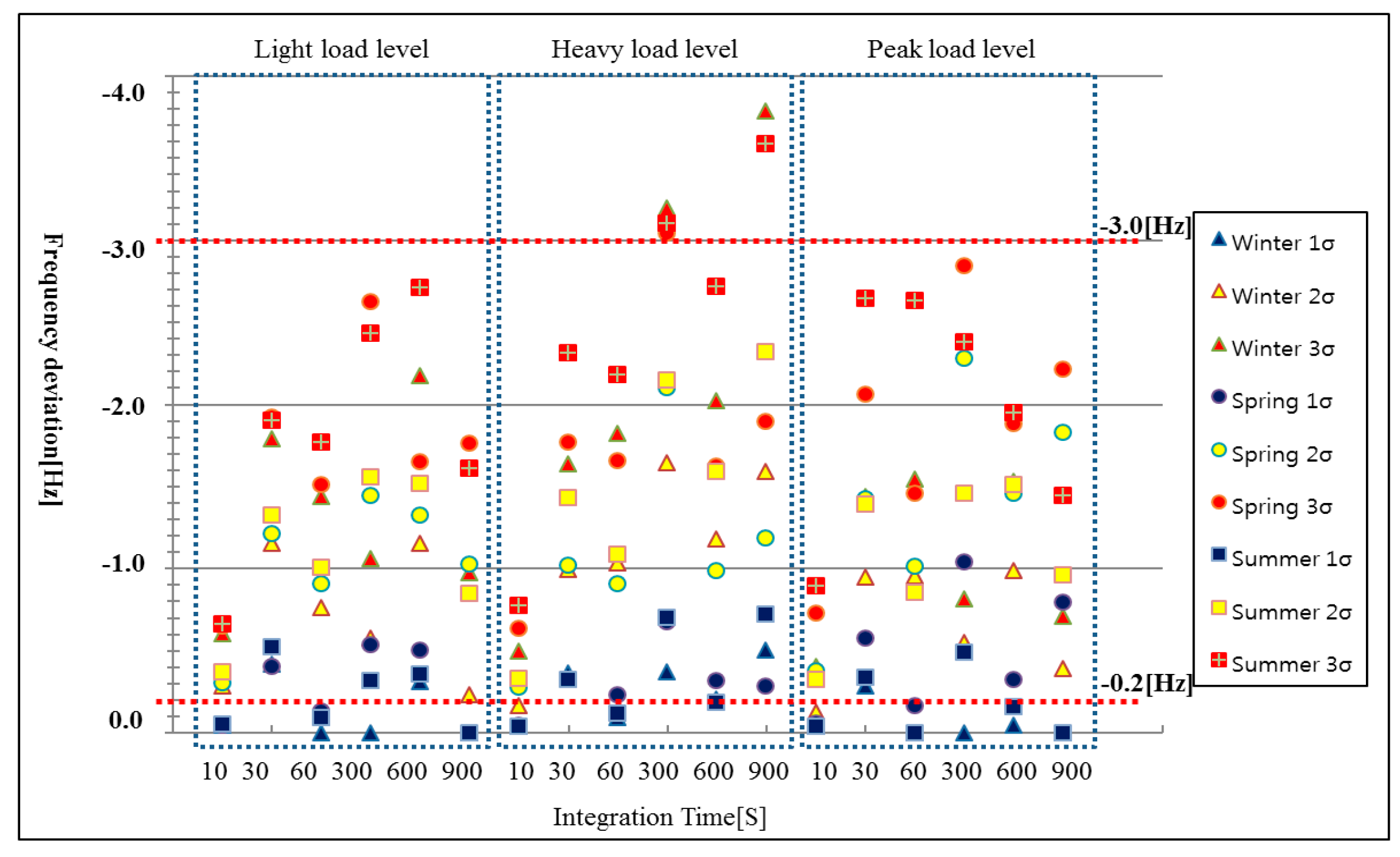
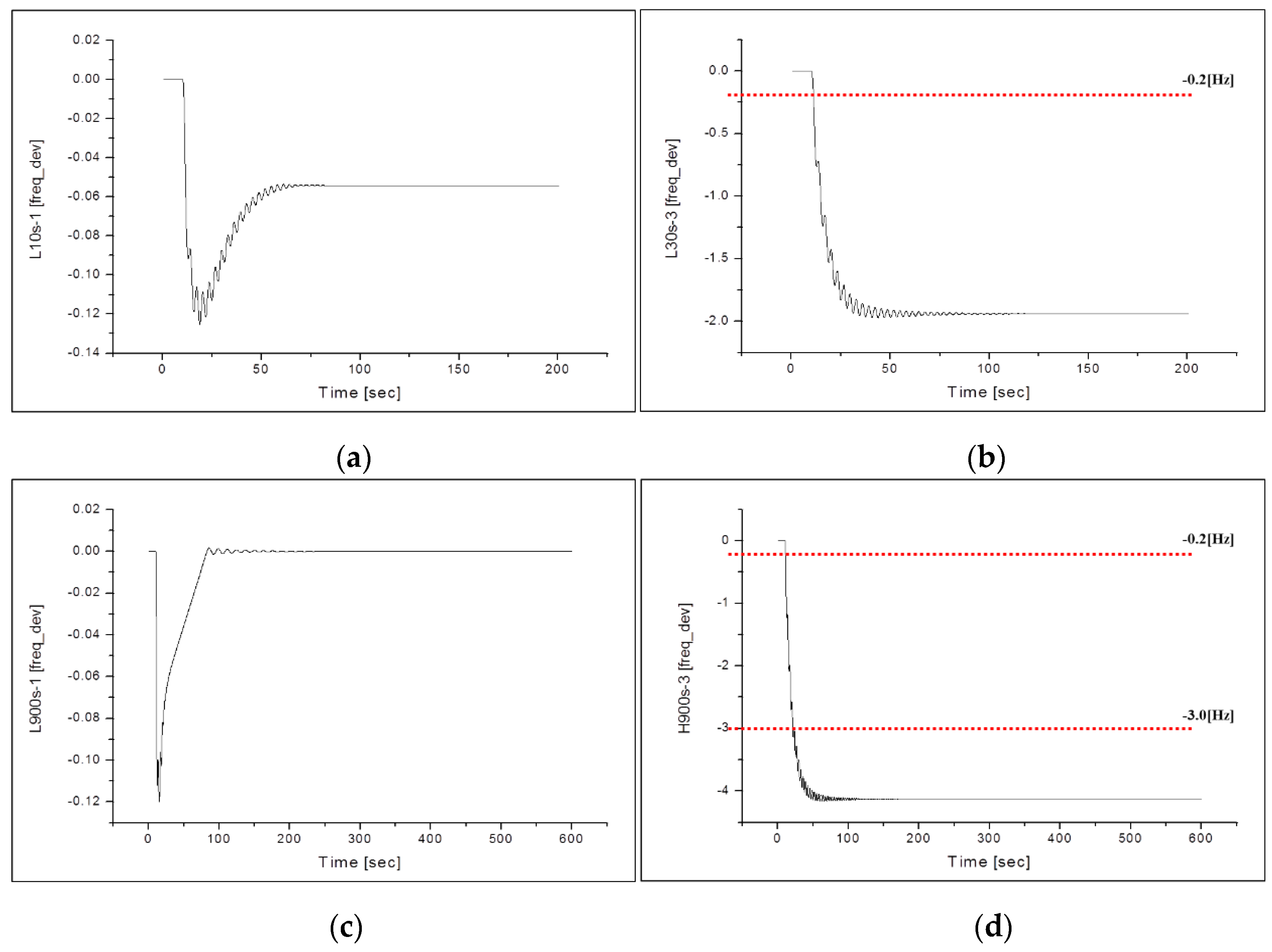
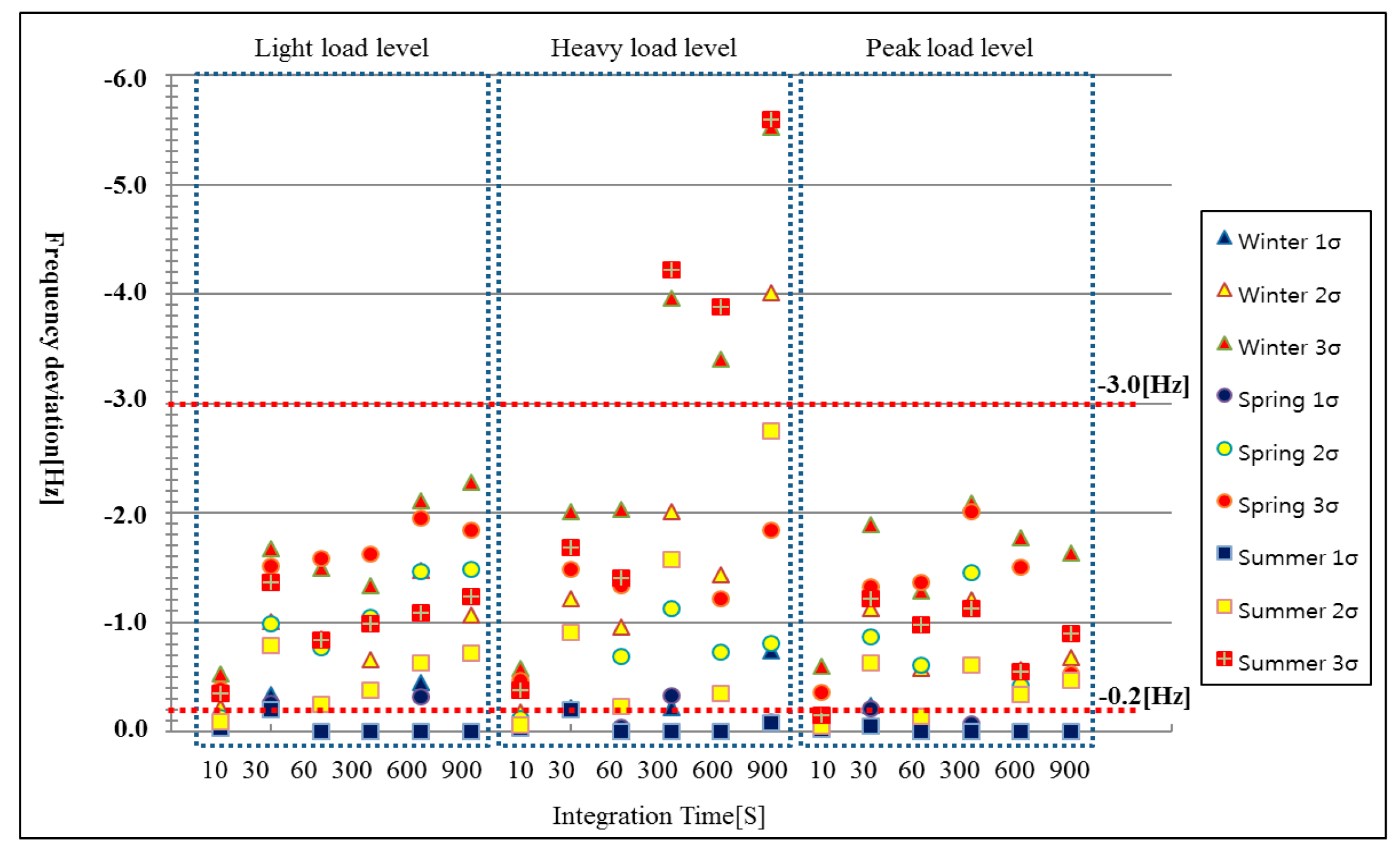
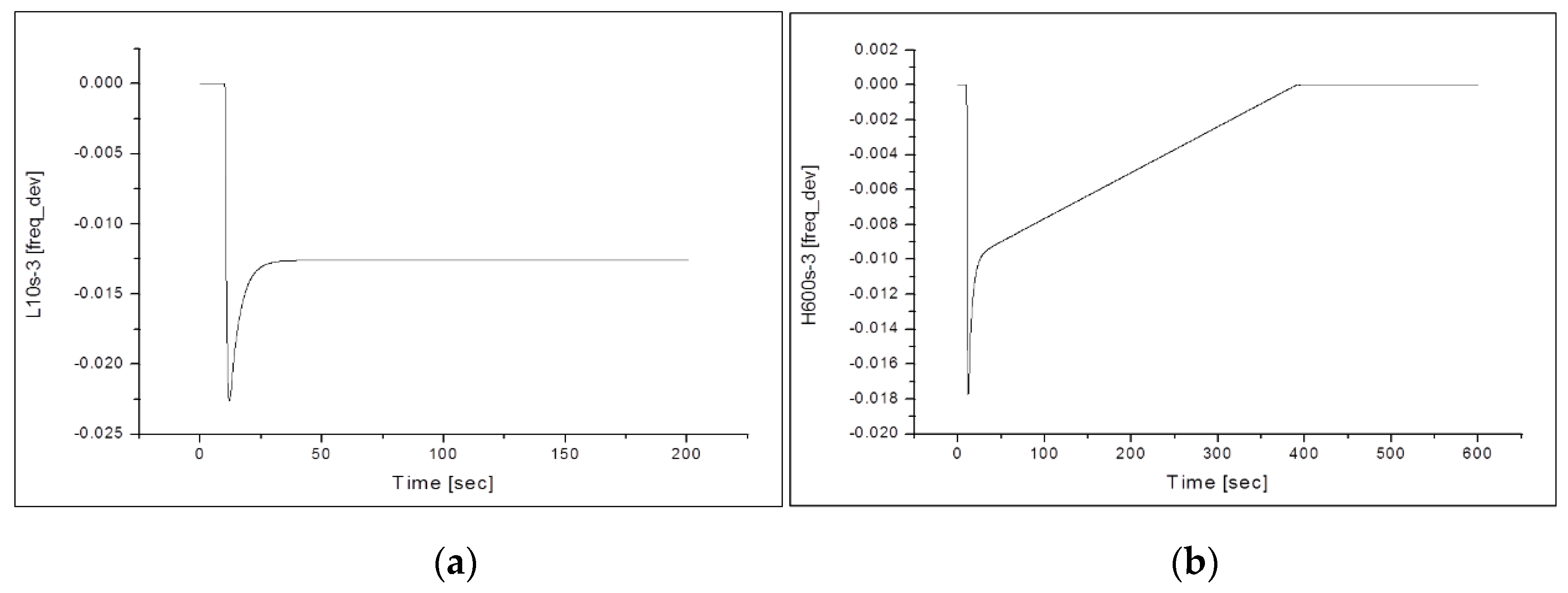

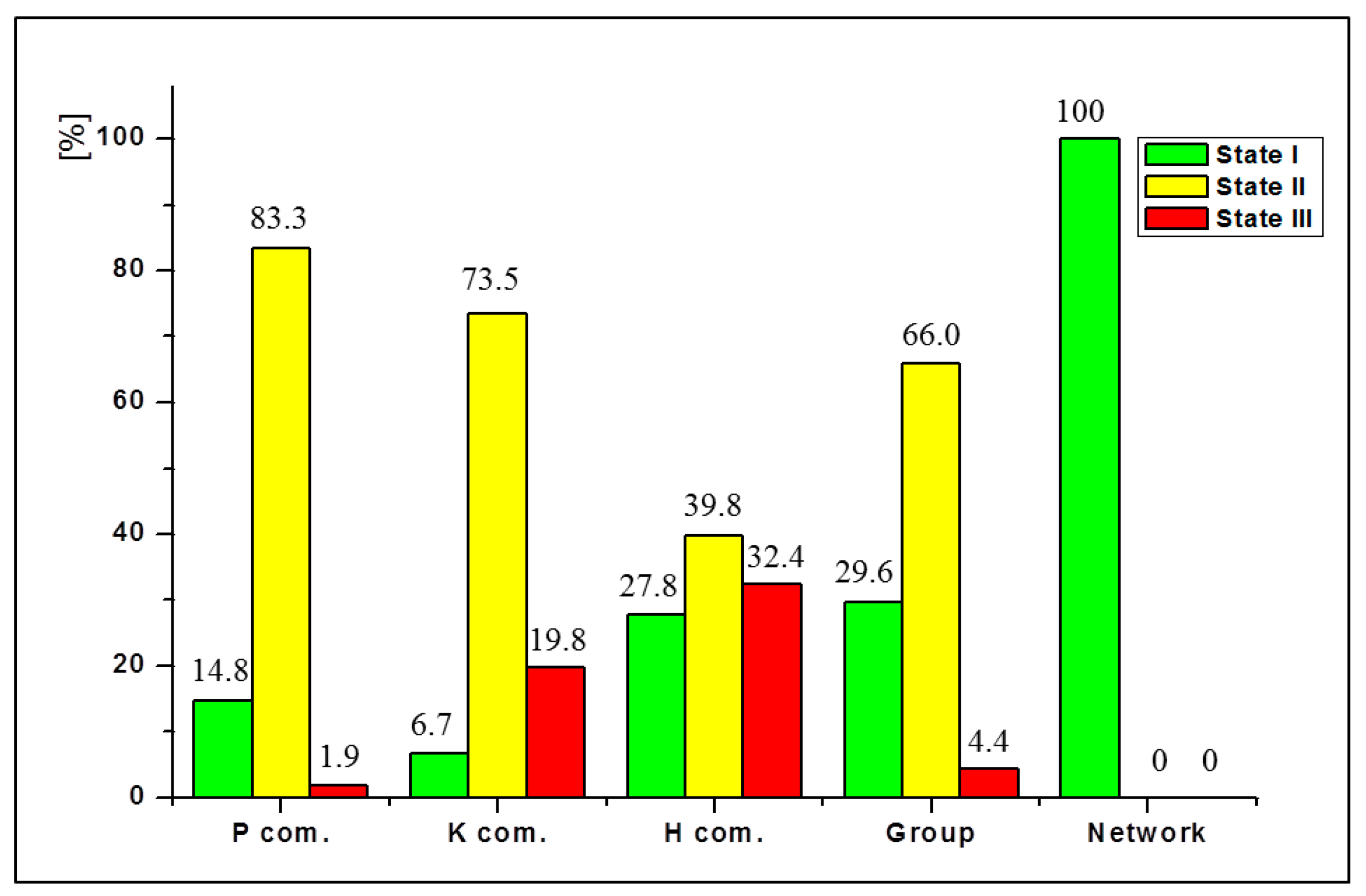
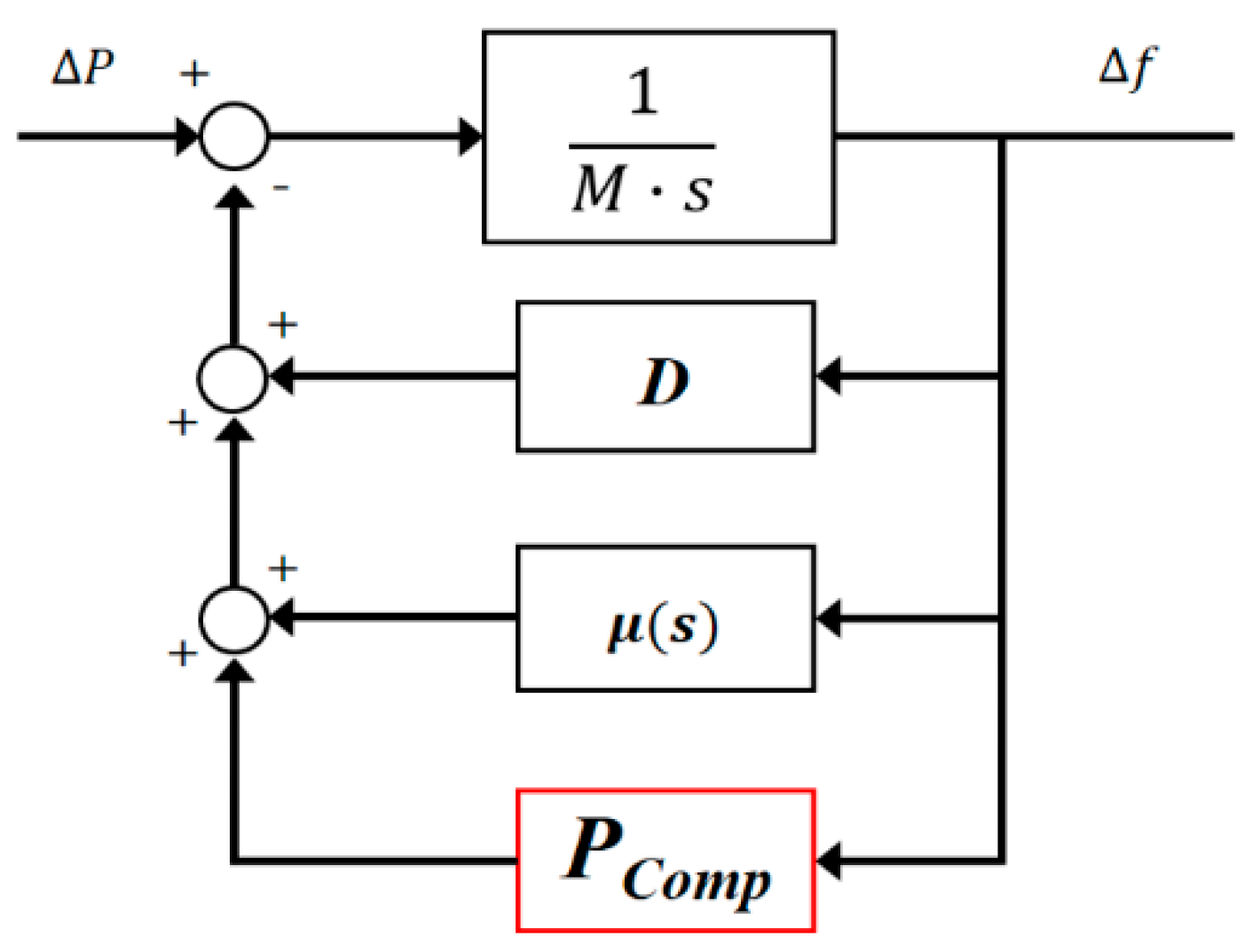
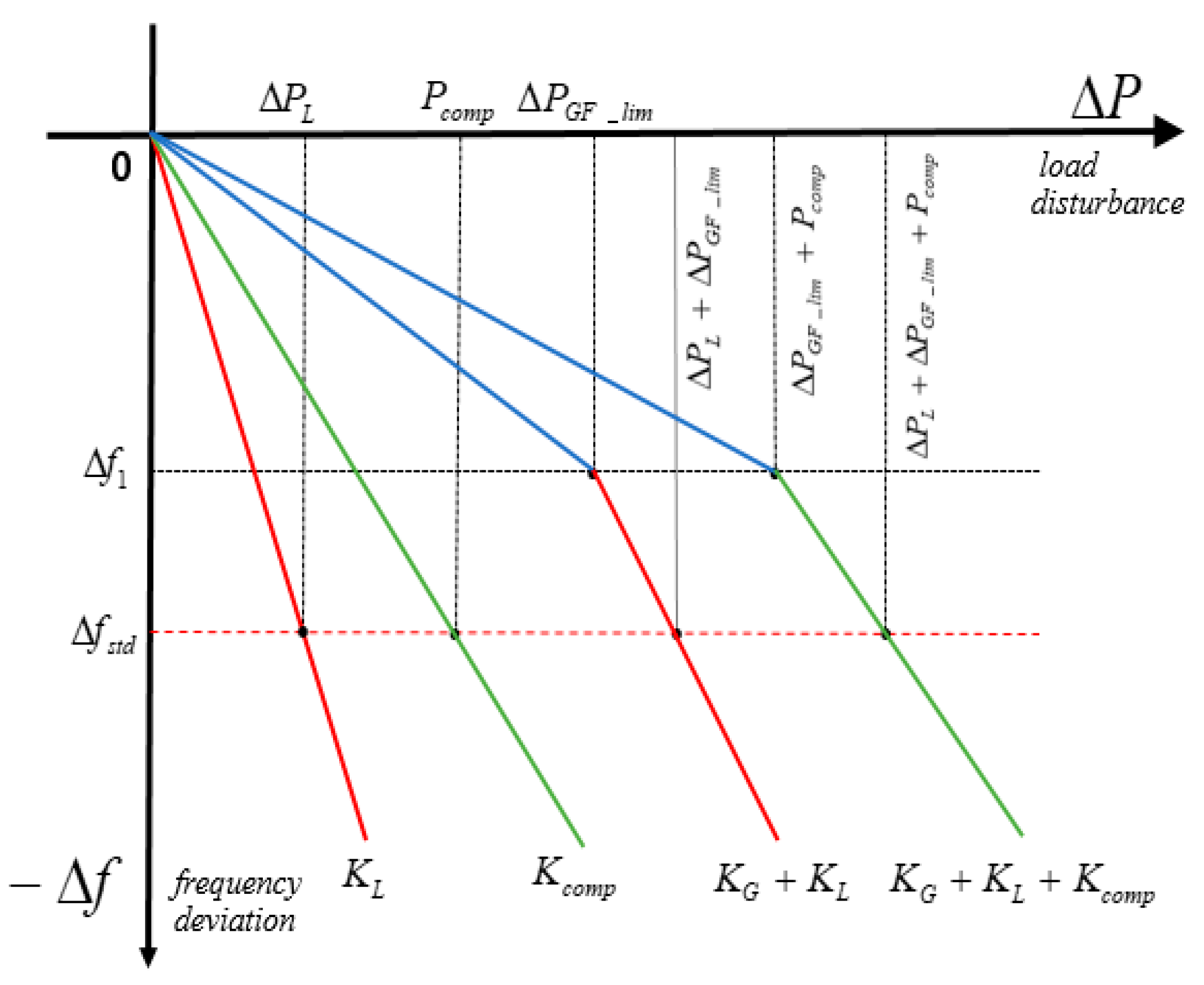
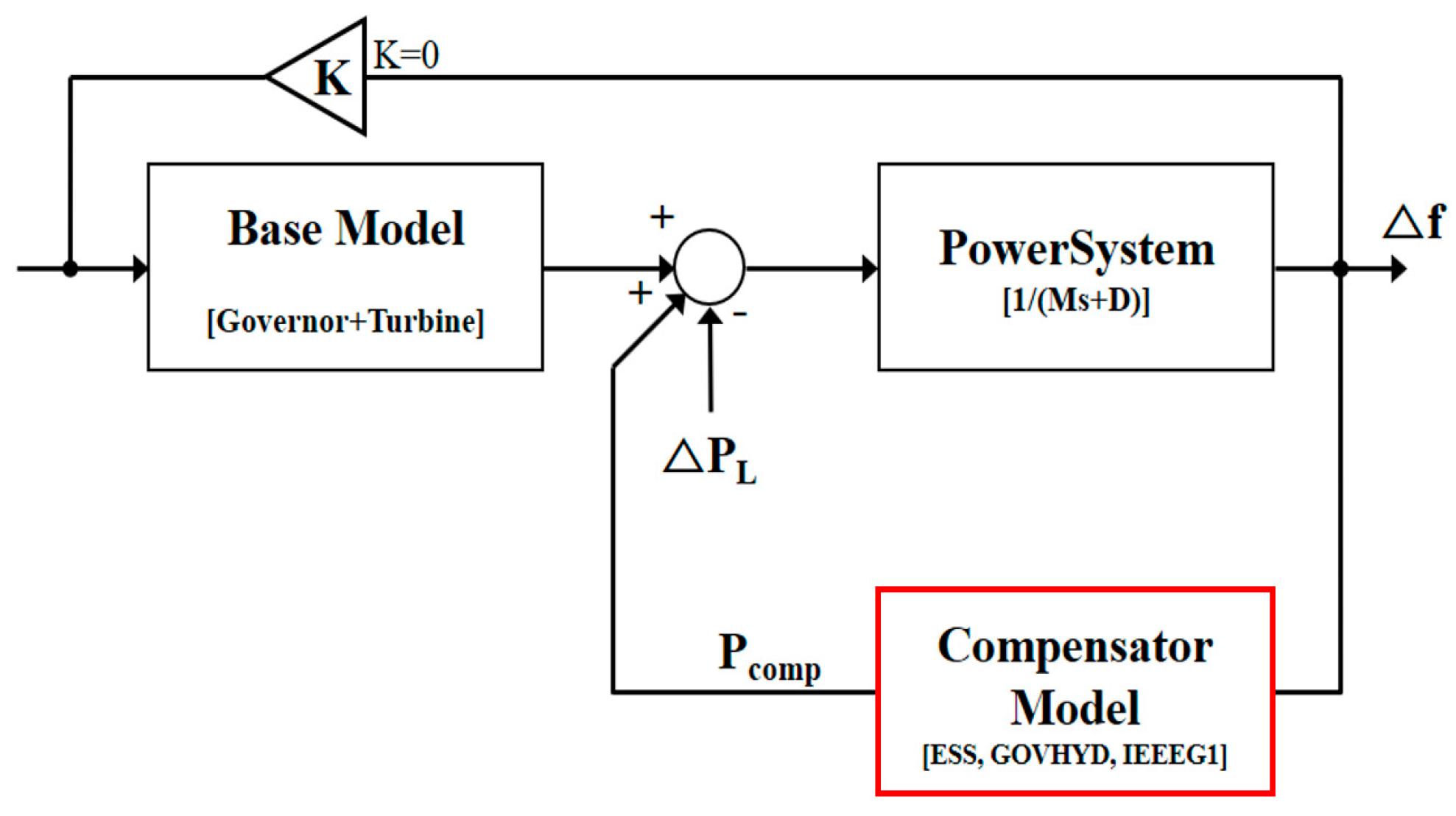


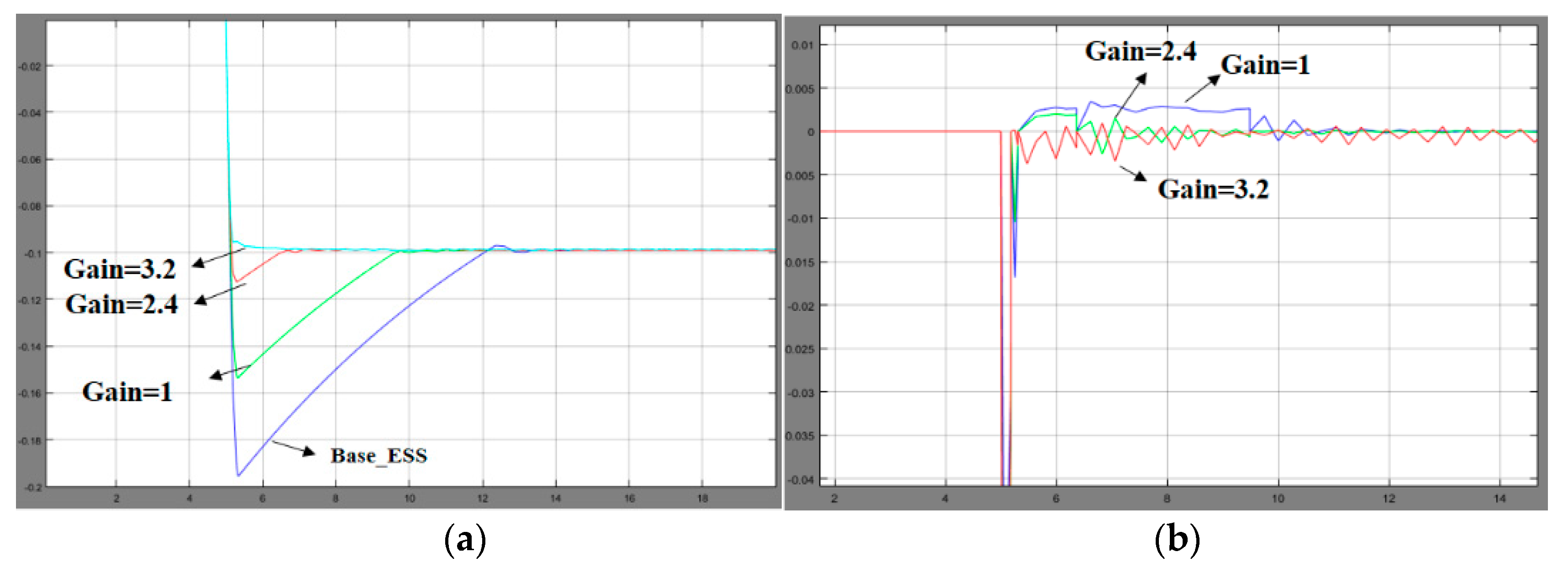

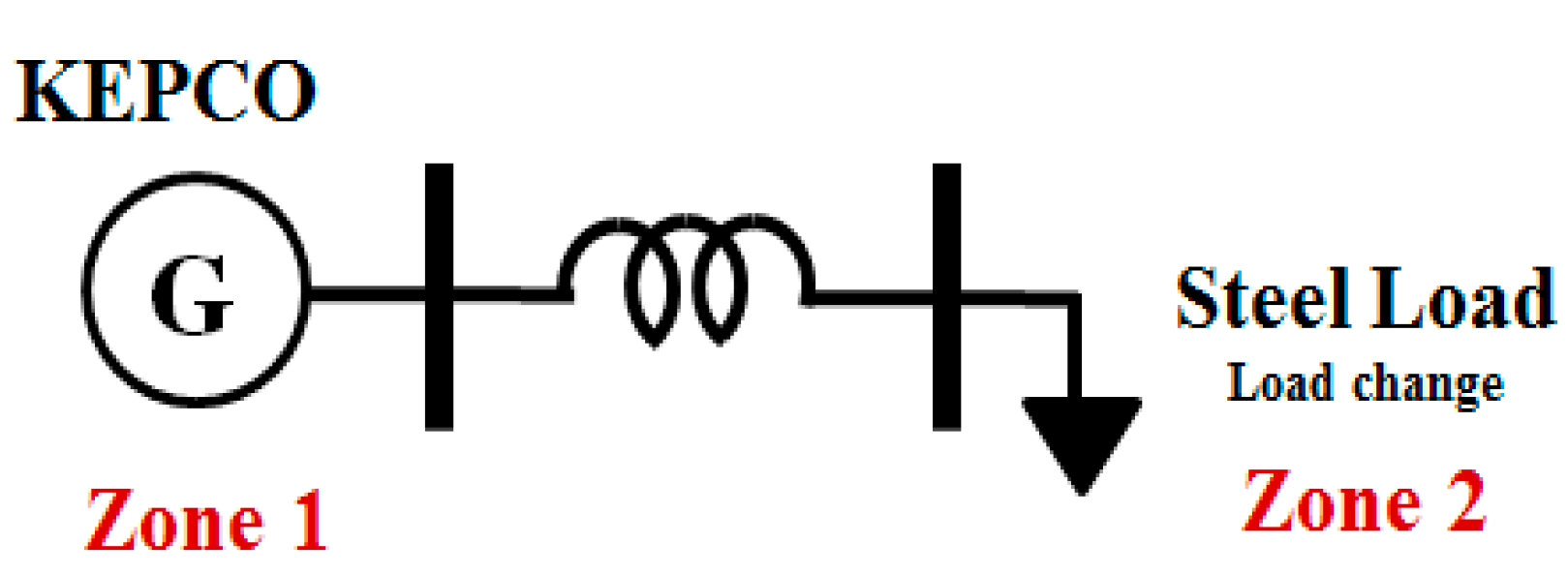

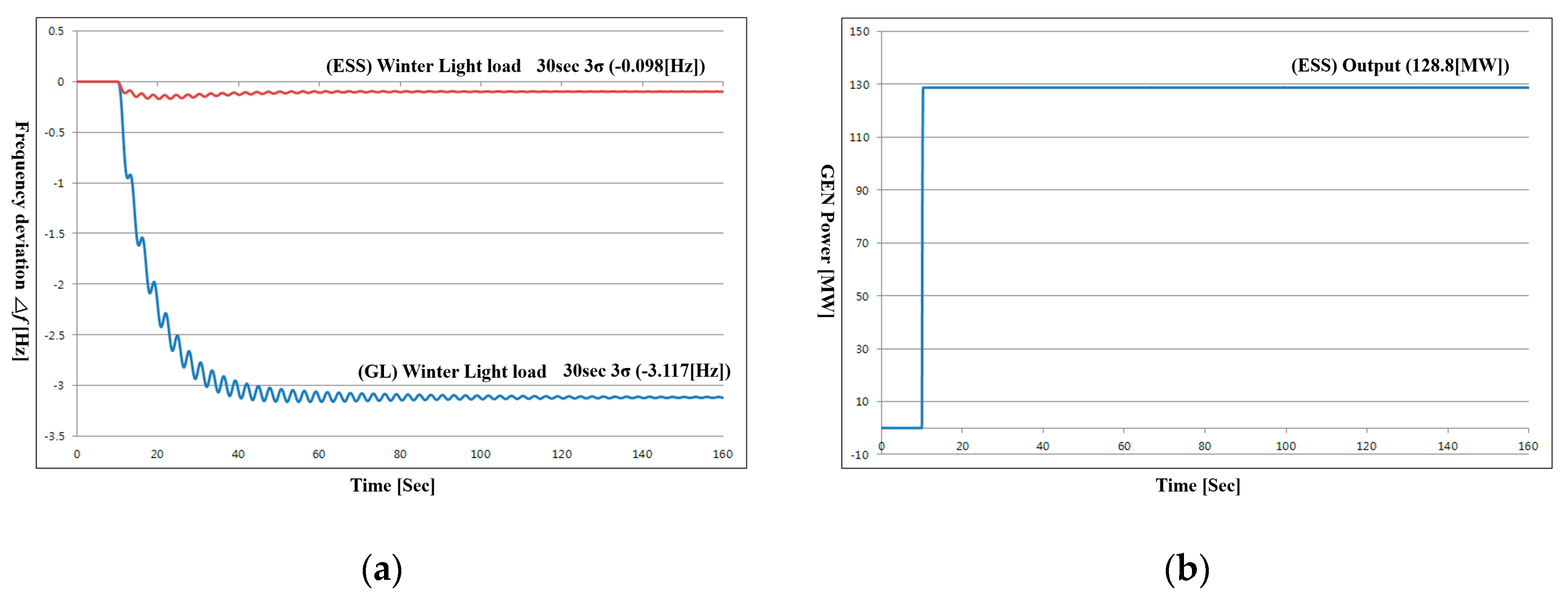

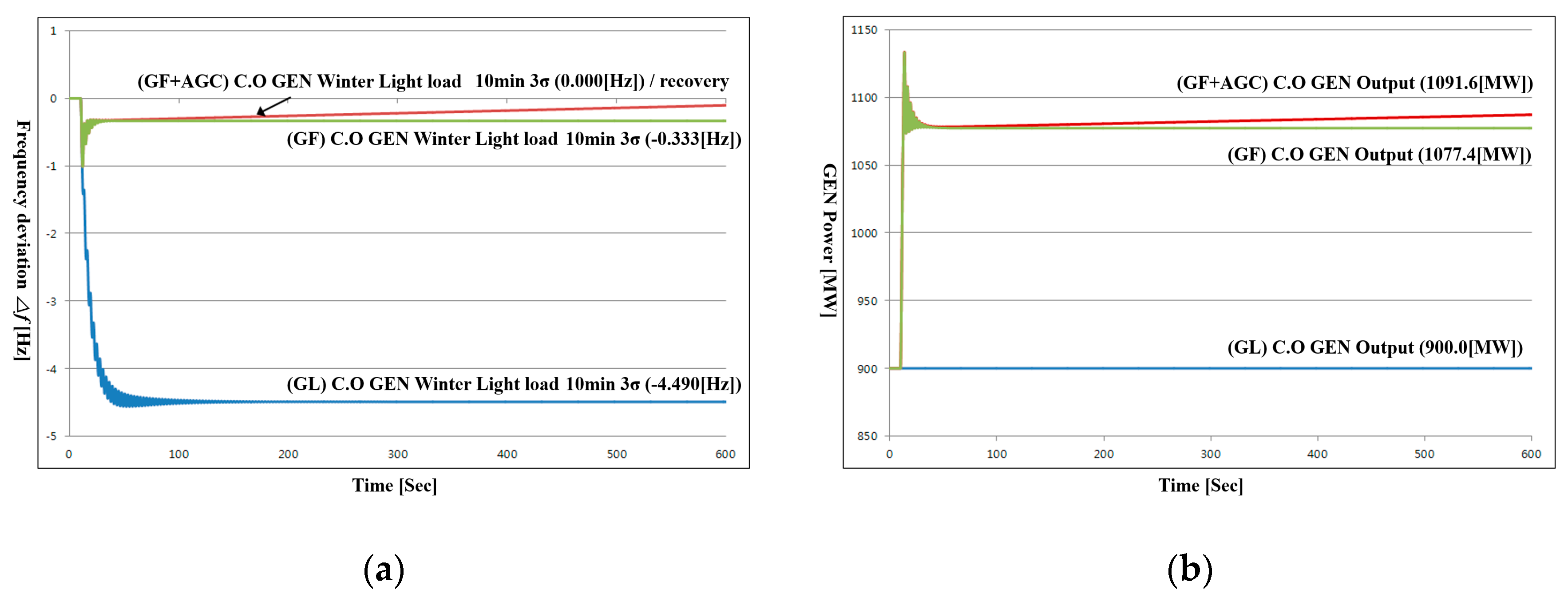
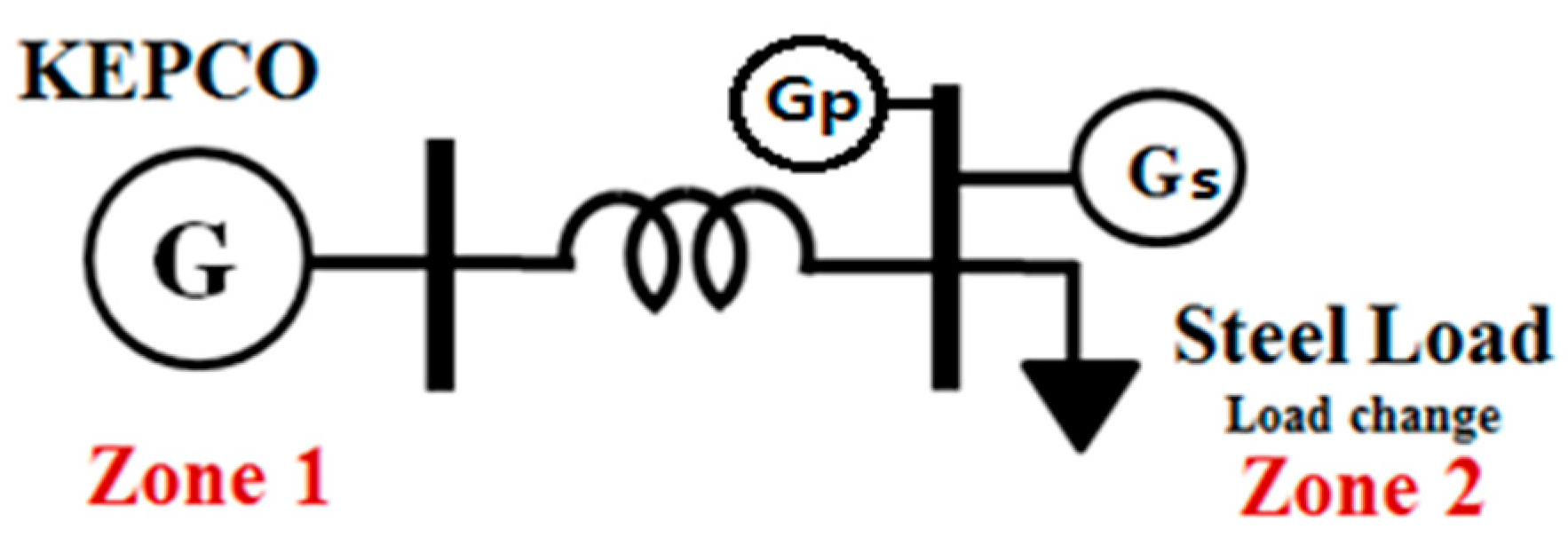

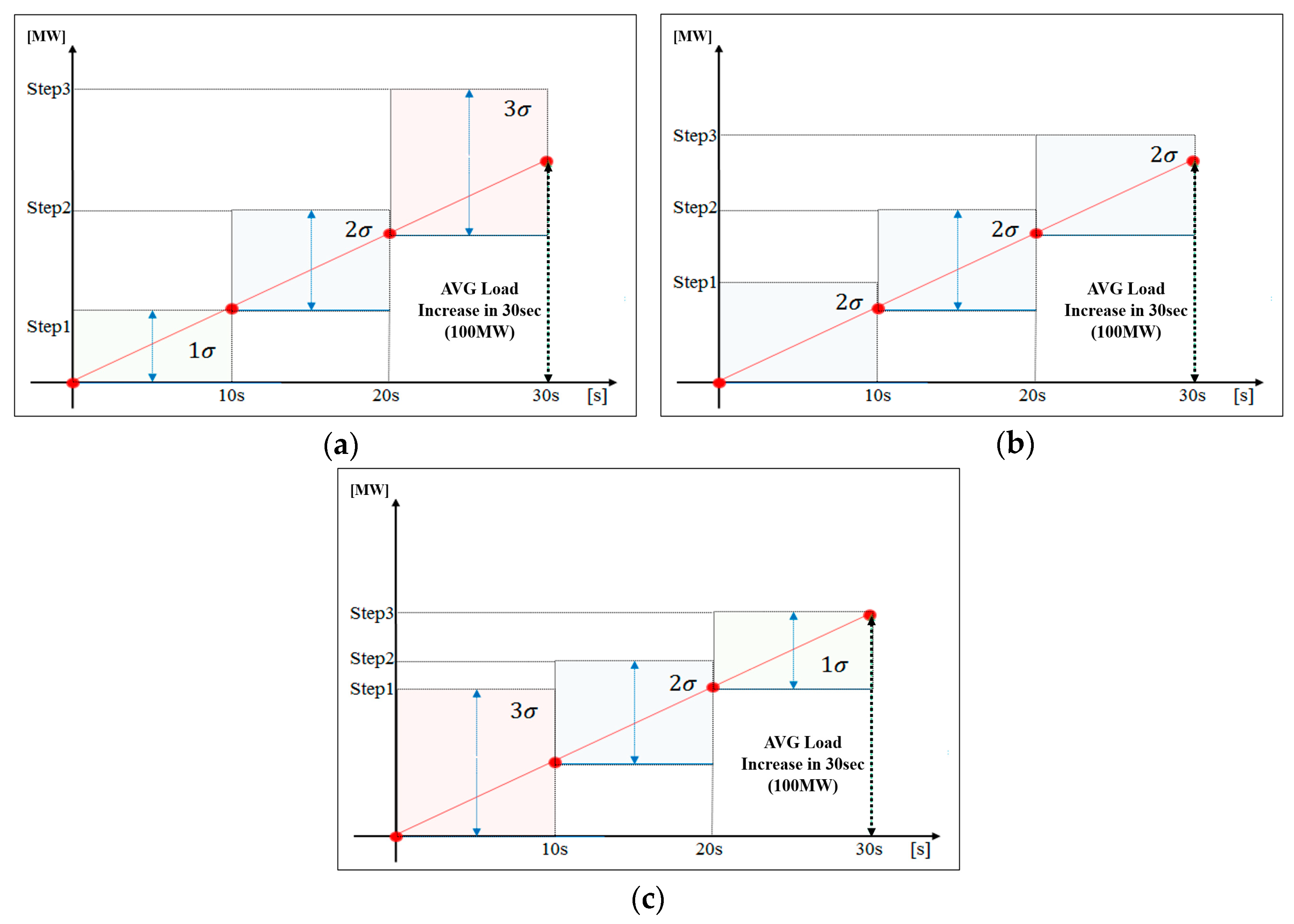
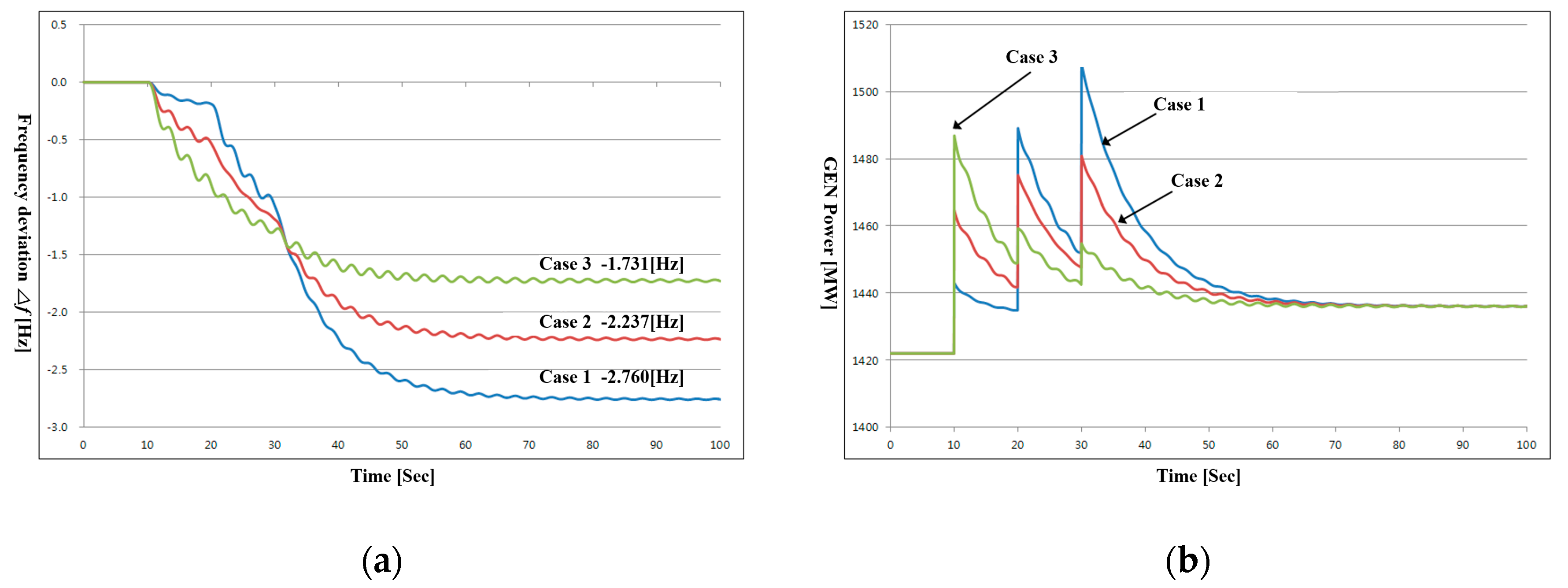
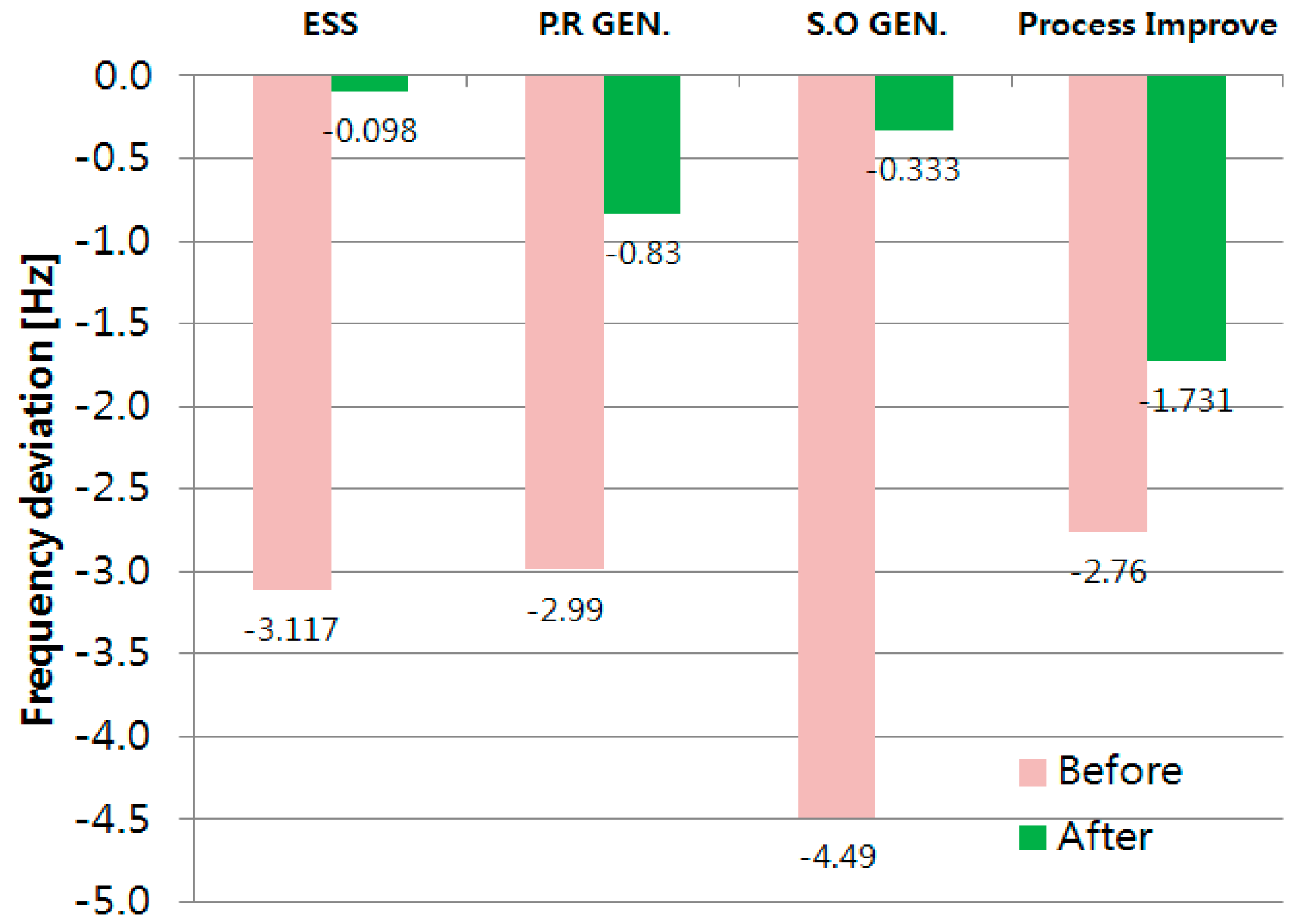
| Section | Regulating Reserve [MW] | Supplemental Reserve [MW] | Total [MW] | ||
|---|---|---|---|---|---|
| G/F | AGC | Operation | Standby | ||
| Normal operation | 1500 | 1000 | 1500 | 4000 | |
| Power supply emergency | 1500 | 1500 | 1000 | 4000 | |
| Frequency Band [Hz] | Period of the Load Fluctuations |
|---|---|
| 0.001–0.002 | 10 [min]–15 [min] |
| 0.003–0.015 | 1 [min]–5 [min] |
| 0.020–0.030 | 40 [s]–60 [s] |
| 0.040–0.050 | 30 [s] |
| Range | Probability [%] | The Probability of Deviating |
|---|---|---|
| μ ± 1σ | 68.26 | 1/3 |
| μ ± 2σ | 95.44 | 1/22 |
| μ ± 3σ | 99.73 | 1/370 |
| Average Time | Note | ||
|---|---|---|---|
| 15 min (Pi+j_15 min) | 1 h increase rate (▽Pi_1 h) | Pi+j_15 min-▽Pi_1 h | j=1,2,3,4(60/15) |
| 10 min (Pi_10 min) | 10 min increase rate (▽Pi_10 min) | Pi_10 min-▽Pi_10 min | - |
| 5 min (Pi+j_5 min) | Pi+j_5 min-▽Pi_10 min | j=1,2(10/5) | |
| 1 min (Pi+j_1 min) | Pi+j_1 min-▽Pi_10 min | j=1,2,…,10(10/1) | |
| 30 s (Pi_30 s) | 30 s increase rate (▽Pi_30 s) | Pi_30 s-▽Pi_30 s | - |
| 10 s (Pi+j_10 s) | Pi+j_10 s-▽Pi_30 s | j=1,2,3(30/10) |
| Winter | Spring | Summer | ||||||||
|---|---|---|---|---|---|---|---|---|---|---|
| Level | Time | 1σ | 2σ | 3σ | 1σ | 2σ | 3σ | 1σ | 2σ | 3σ |
| Peak load | 10 [s] | 29.5 | 62.0 | 85.5 | 33.5 | 68.0 | 107.5 | 26.4 | 53.0 | 86.0 |
| 30 [s] | 70.0 | 140.5 | 199.5 | 75.0 | 152.0 | 253.0 | 61.2 | 125.0 | 201.0 | |
| 1 [min] | 119.5 | 215.0 | 305.5 | 131.4 | 253.0 | 334.0 | 91.5 | 192.4 | 333.8 | |
| 5 [min] | 121.0 | 269.0 | 332.0 | 158.6 | 288.6 | 380.1 | 230.7 | 305.3 | 373.3 | |
| 10 [min] | 133.5 | 304.0 | 479.0 | 135.8 | 290.0 | 358.0 | 88.1 | 245.8 | 401.6 | |
| 15 [min] | 110.0 | 251.0 | 296.0 | 170.4 | 264.5 | 333.5 | 148.1 | 293.8 | 421.0 | |
| Heavy load | 10 [s] | 33.0 | 65.5 | 102.0 | 18.3 | 68.5 | 107.5 | 34.4 | 68.4 | 105.9 |
| 30 [s] | 76.0 | 148.5 | 223.0 | 78.0 | 157.0 | 250.0 | 80.7 | 159.2 | 225.7 | |
| 1 [min] | 107.5 | 209.0 | 323.0 | 110.7 | 214.2 | 322.2 | 102.6 | 208.6 | 340.6 | |
| 5 [min] | 118.0 | 251.0 | 338.0 | 168.9 | 367.9 | 467.9 | 102.4 | 301.4 | 401.4 | |
| 10 [min] | 93.5 | 205.0 | 317.0 | 112.0 | 239.0 | 423.0 | 112.8 | 239.8 | 423.8 | |
| 15 [min] | 164.5 | 382.5 | 475.5 | 146.8 | 221.8 | 272.8 | 133.5 | 208.5 | 259.5 | |
| Light load | 10 [s] | 34.0 | 72.5 | 109.0 | 73.4 | 73.6 | 109.6 | 36.7 | 74.3 | 114.3 |
| 30 [s] | 82.0 | 171.5 | 237.0 | 86.7 | 168.7 | 257.2 | 86.1 | 169.6 | 254.6 | |
| 1 [min] | 112.5 | 230.0 | 317.0 | 113.1 | 233.1 | 357.1 | 107.3 | 225.8 | 353.8 | |
| 5 [min] | 24.0 | 150.0 | 295.0 | 163.9 | 346.4 | 551.4 | 116.6 | 261.1 | 358.1 | |
| 10 [min] | 140.5 | 344.0 | 429.0 | 168.0 | 298.0 | 418.0 | 151.7 | 291.2 | 428.7 | |
| 15 [min] | 75.5 | 259.0 | 362.0 | 62.5 | 278.5 | 422.5 | 56.1 | 196.6 | 245.6 | |
| Zone1 (KEPCO) Supply Side | Zone2 (Steel Load) Demand Side | |
|---|---|---|
| Generator installed capacity | 54,500 [MW] | - |
| Generator output | 51,603 [MW] | |
| Demand capacity | 51,503 [MW] | 100 [MW] |
| Governor and Turbine model | IEEEG1 2 [ea] | - |
| Speed Droop | 5.68% | - |
| Load-Frequency Damping | 2 | 2 |
| Transmission reactance | 0.00297 + j0.03179 [Ω] | |
| Load Fluctuation | - | 500 [MW] |
| Supply Side | P Company (Demand Side) | Demand Capacity | Season | Power System Load Level | ||||
|---|---|---|---|---|---|---|---|---|
| Generation | Load | Generation | Load Level | |||||
| Installed Capacity | Out -Put | Installed Capacity | Out -Put | |||||
| 710 | 648 | - | 1200 | 760 | 1408 | 648 | Winter | light |
| 250 | 1010 | 250 | heavy | |||||
| 193 | 953 | 193 | peak | |||||
| 607 | 1367 | 607 | Spring | light | ||||
| 622 | 1382 | 622 | heavy | |||||
| 542 | 1302 | 542 | peak | |||||
| 637 | 1397 | 637 | Summer | light | ||||
| 290 | 1050 | 290 | heavy | |||||
| 320 | 990 | 230 | peak | |||||
| ※ system constant: %K = 0.8 [%MW/0.1 Hz] (%KG = 0.5, %KL = 0.3) ※ reserve: = 14.41[MW], = 28.76 [MW] (winter/summer), 24.00 [MW] (spring) | ||||||||
| Supply Side | Steel Company Group (Demand Side) | Demand Capacity | Season | Power System Load Level | ||||
|---|---|---|---|---|---|---|---|---|
| Generation | Load | Generation | Load Level | |||||
| Installed Capacity | Out -Put | Installed Capacity | Out -Put | |||||
| 1400 | 1154 | - | 2800 | 1660 | 2814 | 1154 | Winter | light |
| 151 | 1811 | 151 | heavy | |||||
| 0 | 38 | 1622 | −38 | peak | ||||
| 1990 | 1312 | 2972 | 1312 | Spring | light | |||
| 1344 | 3004 | 1344 | heavy | |||||
| 1020 | 2680 | 1020 | peak | |||||
| 1736 | 3396 | 1736 | Summer | light | ||||
| 1009 | 2669 | 1009 | heavy | |||||
| 591 | 2251 | 591 | peak | |||||
| ※ system constant: %K = 0.8 [%MW/0.1 Hz] (%KG = 0.5, %KL = 0.3) ※ reserve: = 28.42 [MW] (winter), 40.40 [MW] (spring/summer) = 56.70 [MW] (winter), 67.26 [MW] (spring), 80.60 [MW] (summer) | ||||||||
| Supply Side | All Steel Company (Demand Side) | Demand Capacity | Season | Power System Load Level | ||||
|---|---|---|---|---|---|---|---|---|
| Generation | Load | Generation | Load Level | |||||
| Installed Capacity | Out -Put | Installed Capacity | Out -Put | |||||
| 80,713 | 58,391 | 55,383 | - | - | 3008 | 3008 | Winter | light |
| 67,080 | 64,773 | 2307 | 2307 | heavy | ||||
| 72,463 | 70,848 | 1615 | 1615 | peak | ||||
| 70,225 | 50,771 | 47,559 | 3212 | 3212 | Spring | light | ||
| 59,754 | 56,701 | 3053 | 3053 | heavy | ||||
| 59,344 | 57,306 | 2038 | 2038 | peak | ||||
| 78,734 | 52,227 | 48,970 | 3257 | 3257 | Summer | light | ||
| 72,860 | 70,496 | 2364 | 2364 | heavy | ||||
| 73,714 | 72,488 | 1226 | 1226 | peak | ||||
| ※ system constant: %K = 0.8 [%MW/0.1 Hz] (%KG = 0.5, %KL = 0.3) ※ reserve: = 1500 [MW], = 3000 [MW] (winter/summer), 2500 [MW] (spring) | ||||||||
| KEPCO (Supply Side) | Steel Mill B (Demand Side) | Demand Capacity | Season | Power System Load Level | ||||
|---|---|---|---|---|---|---|---|---|
| Generation | Load | Generation | Load Level | |||||
| Installed Capacity | Out -Put | Installed Capacity | Out -Put | |||||
| 600 | 522 | - | 1600 | 900 (fixed) | 1422 | 522 | Winter | light |
| ※ system constant: %K = 0.8% MW/0.1 Hz (%KG = 0.5, %KL = 0.3) ※ reserve: = 14.01 [MW], = 27.95 [MW] (winter/summer) | ||||||||
| Case | Load Fluctuation within 10 s (MW) | Load Increase 30 s | ||
|---|---|---|---|---|
| Case 1 (Original process) | 21 (1σ) | 42 (2σ) | 65 (3σ) | 100 (2σ) |
| Case 2 (Re-distribution) | 42 (2σ) | 42 (2σ) | 42 (2σ) | |
| Case 3 (Re-allocation) | 65 (3σ) | 42 (2σ) | 21 (1σ) | |
© 2020 by the authors. Licensee MDPI, Basel, Switzerland. This article is an open access article distributed under the terms and conditions of the Creative Commons Attribution (CC BY) license (http://creativecommons.org/licenses/by/4.0/).
Share and Cite
Lee, Y.; Lee, H.; Gim, J.; Seo, I.; Lee, G. Technical Measures to Mitigate Load Fluctuation for Large-Scale Customers to Improve Power System Energy Efficiency. Energies 2020, 13, 4812. https://doi.org/10.3390/en13184812
Lee Y, Lee H, Gim J, Seo I, Lee G. Technical Measures to Mitigate Load Fluctuation for Large-Scale Customers to Improve Power System Energy Efficiency. Energies. 2020; 13(18):4812. https://doi.org/10.3390/en13184812
Chicago/Turabian StyleLee, Yongsik, Hyunchul Lee, Jaehyeon Gim, Inyong Seo, and Guenjoon Lee. 2020. "Technical Measures to Mitigate Load Fluctuation for Large-Scale Customers to Improve Power System Energy Efficiency" Energies 13, no. 18: 4812. https://doi.org/10.3390/en13184812
APA StyleLee, Y., Lee, H., Gim, J., Seo, I., & Lee, G. (2020). Technical Measures to Mitigate Load Fluctuation for Large-Scale Customers to Improve Power System Energy Efficiency. Energies, 13(18), 4812. https://doi.org/10.3390/en13184812






